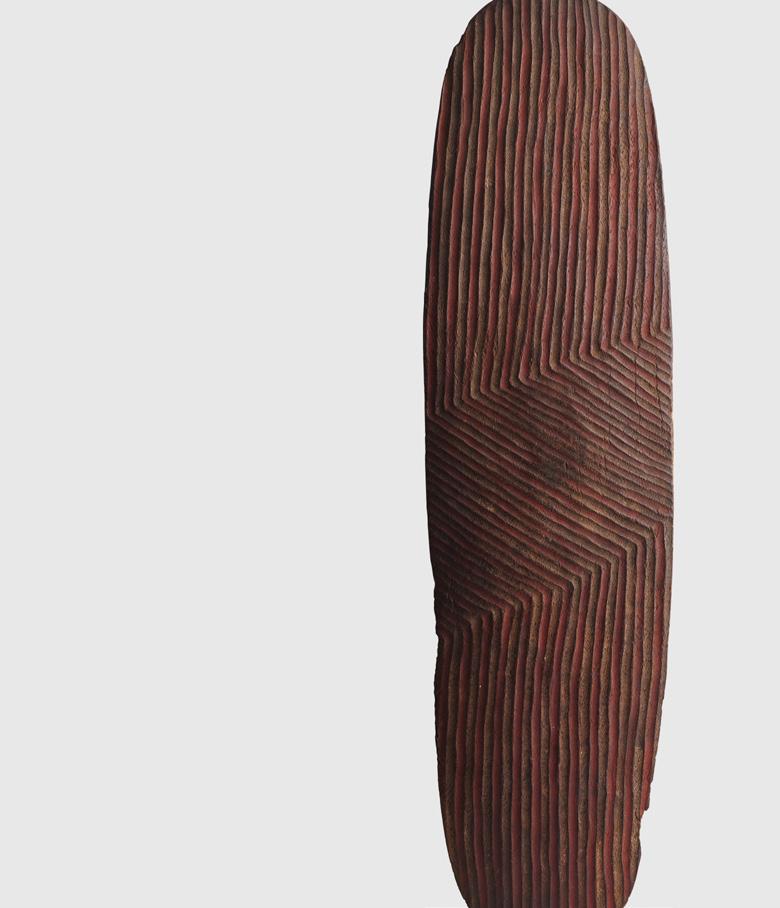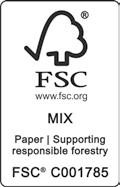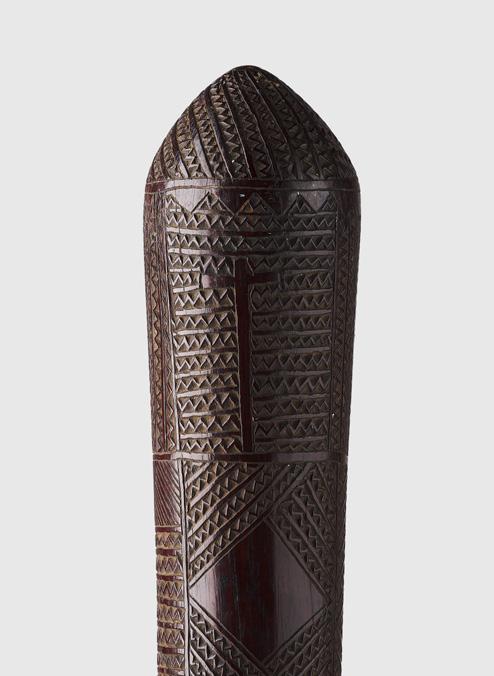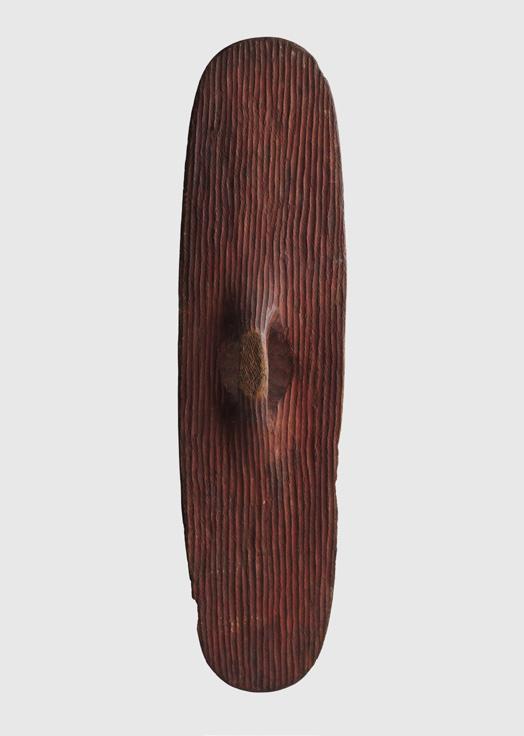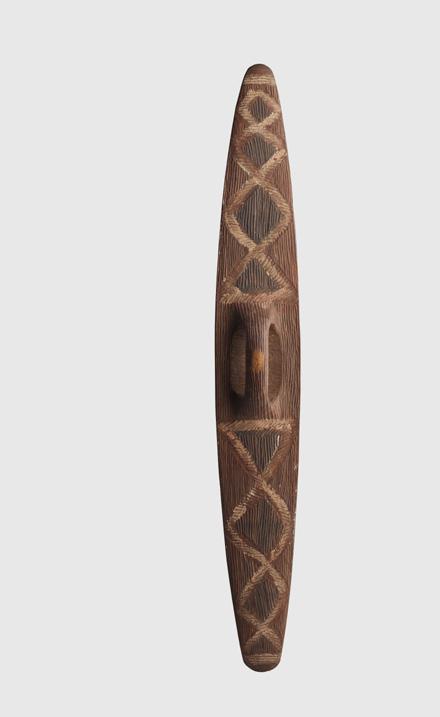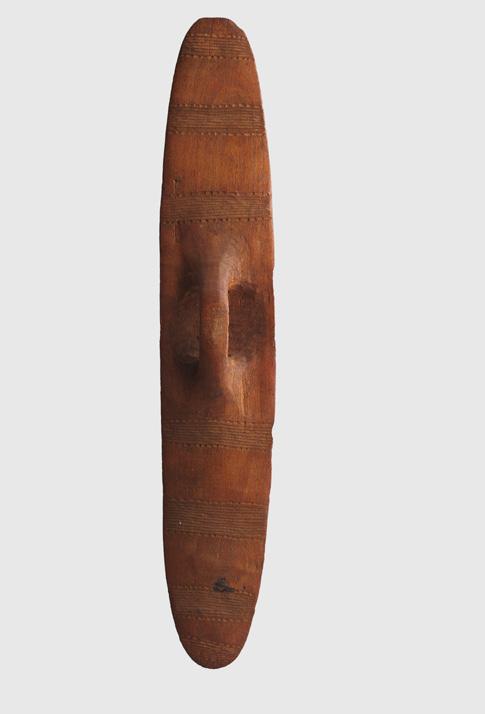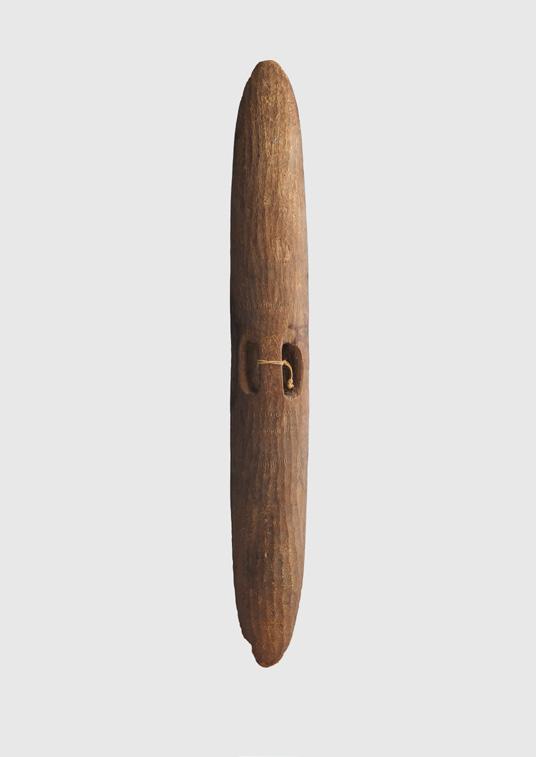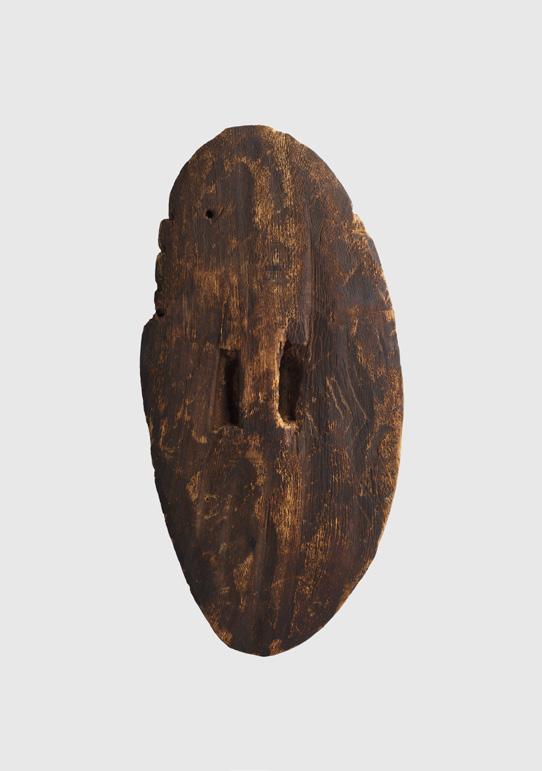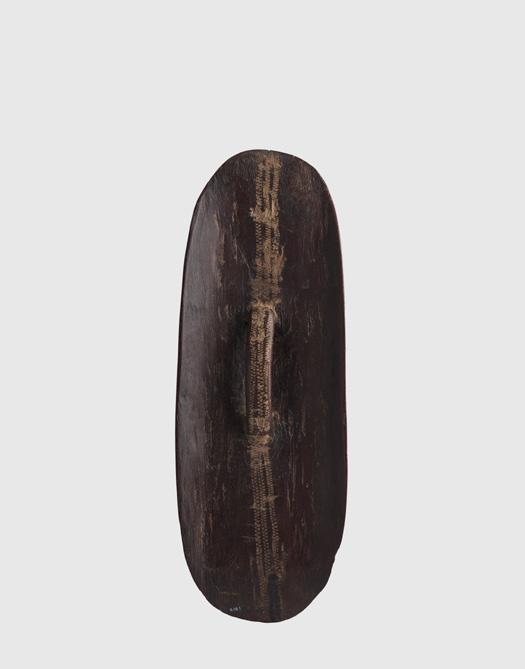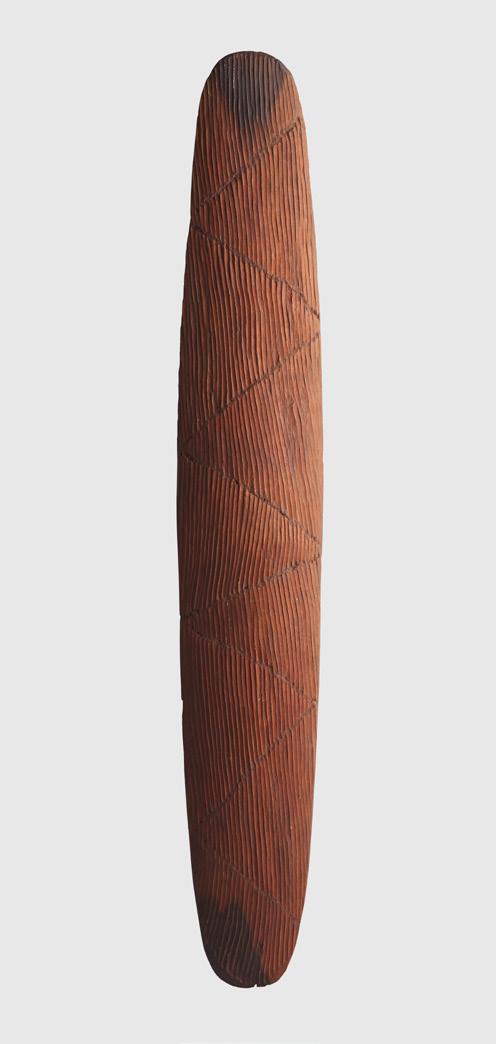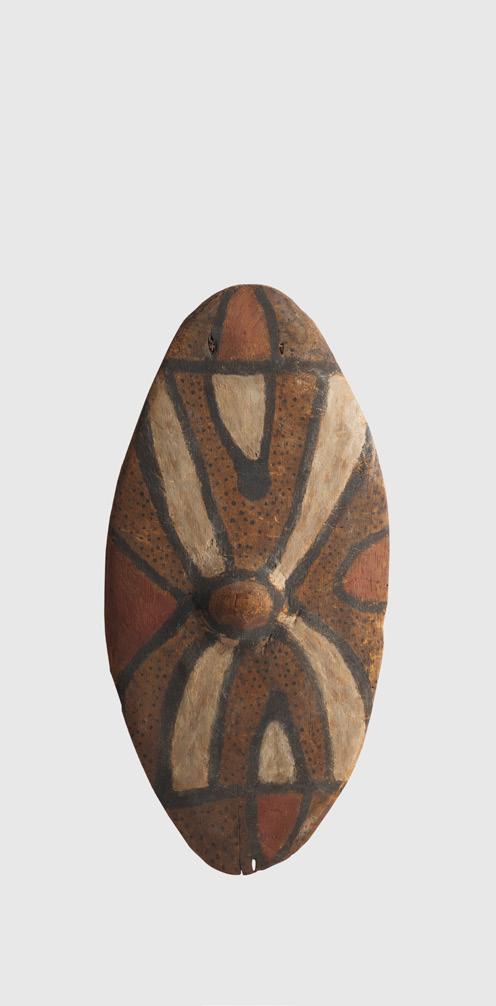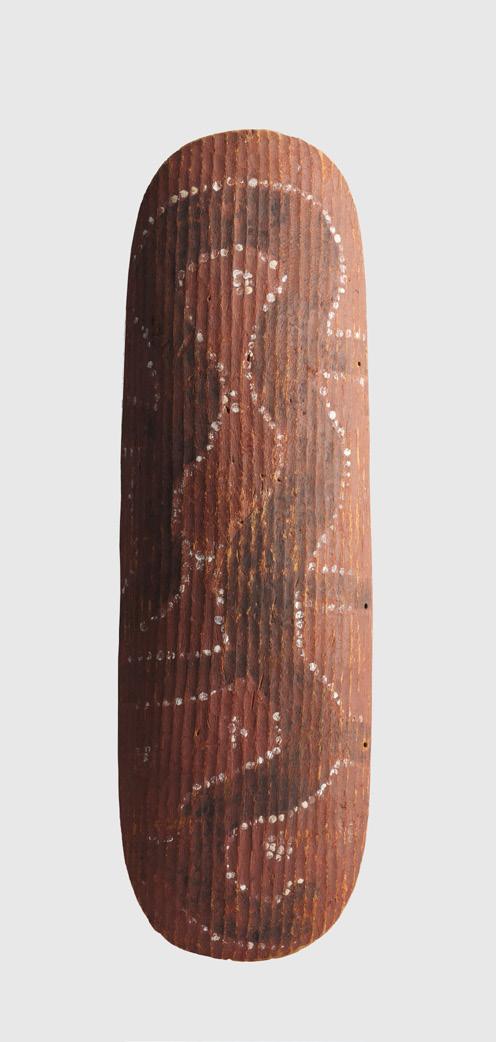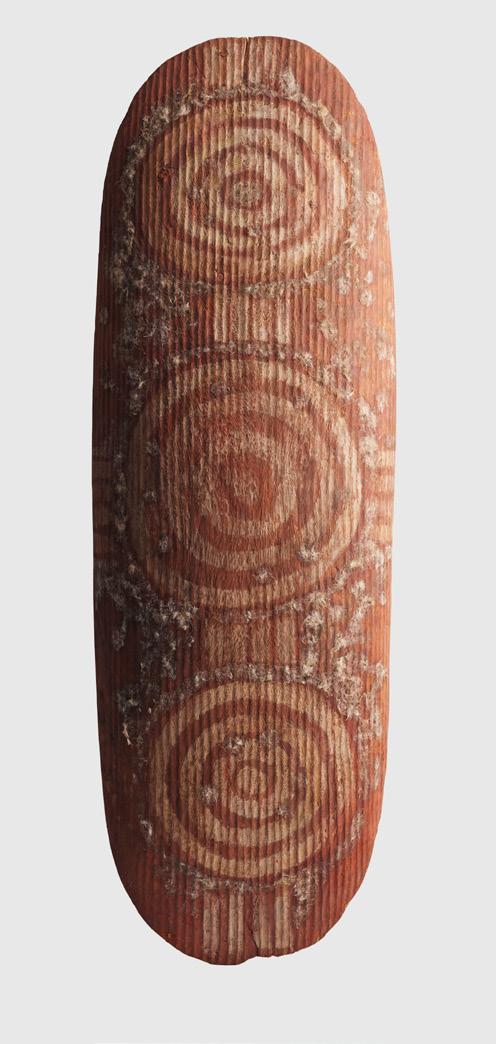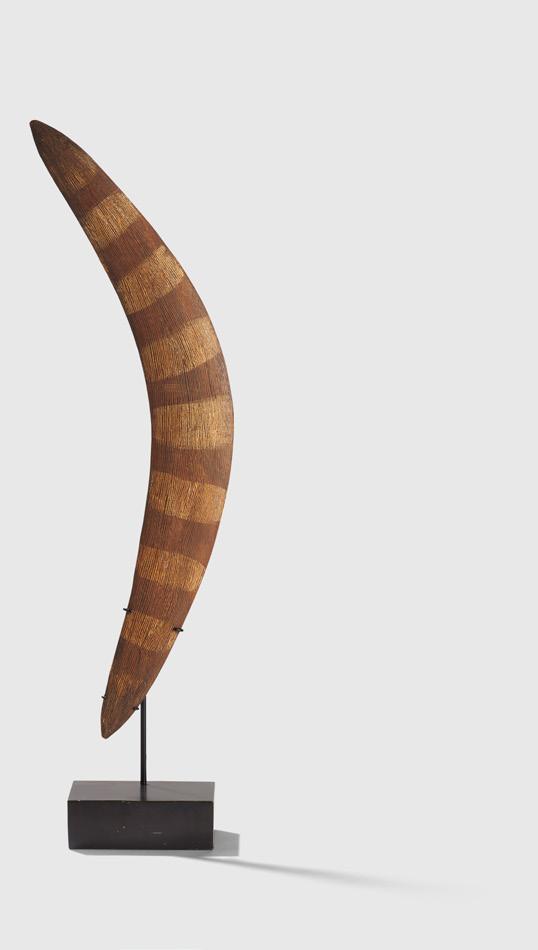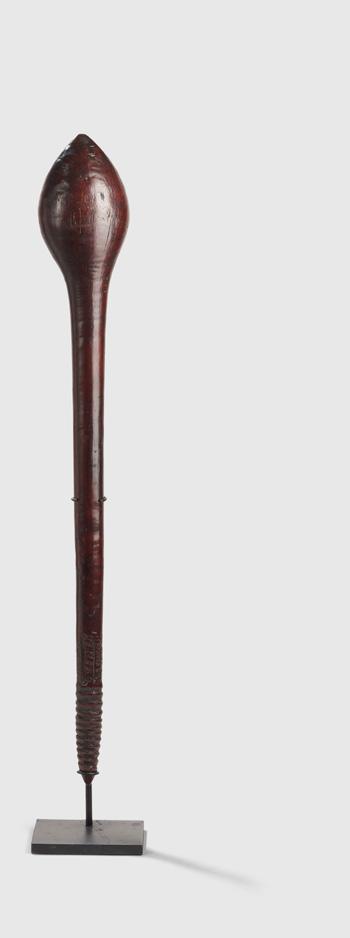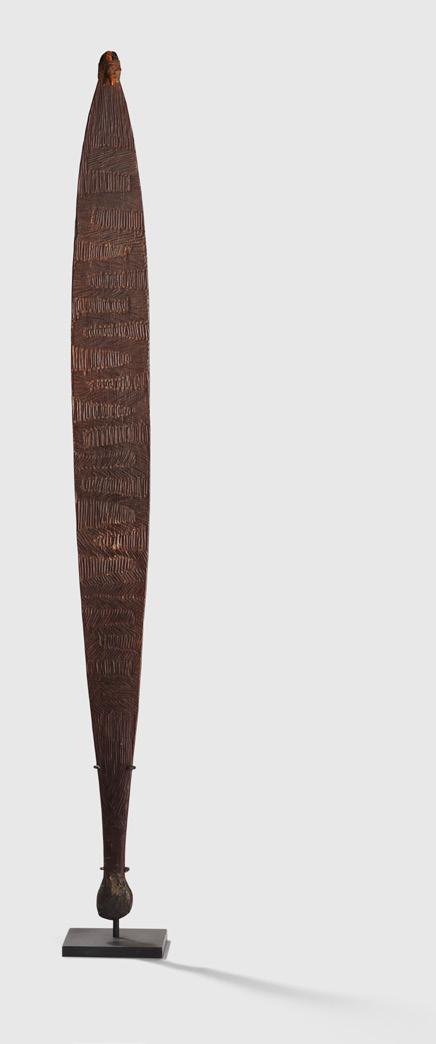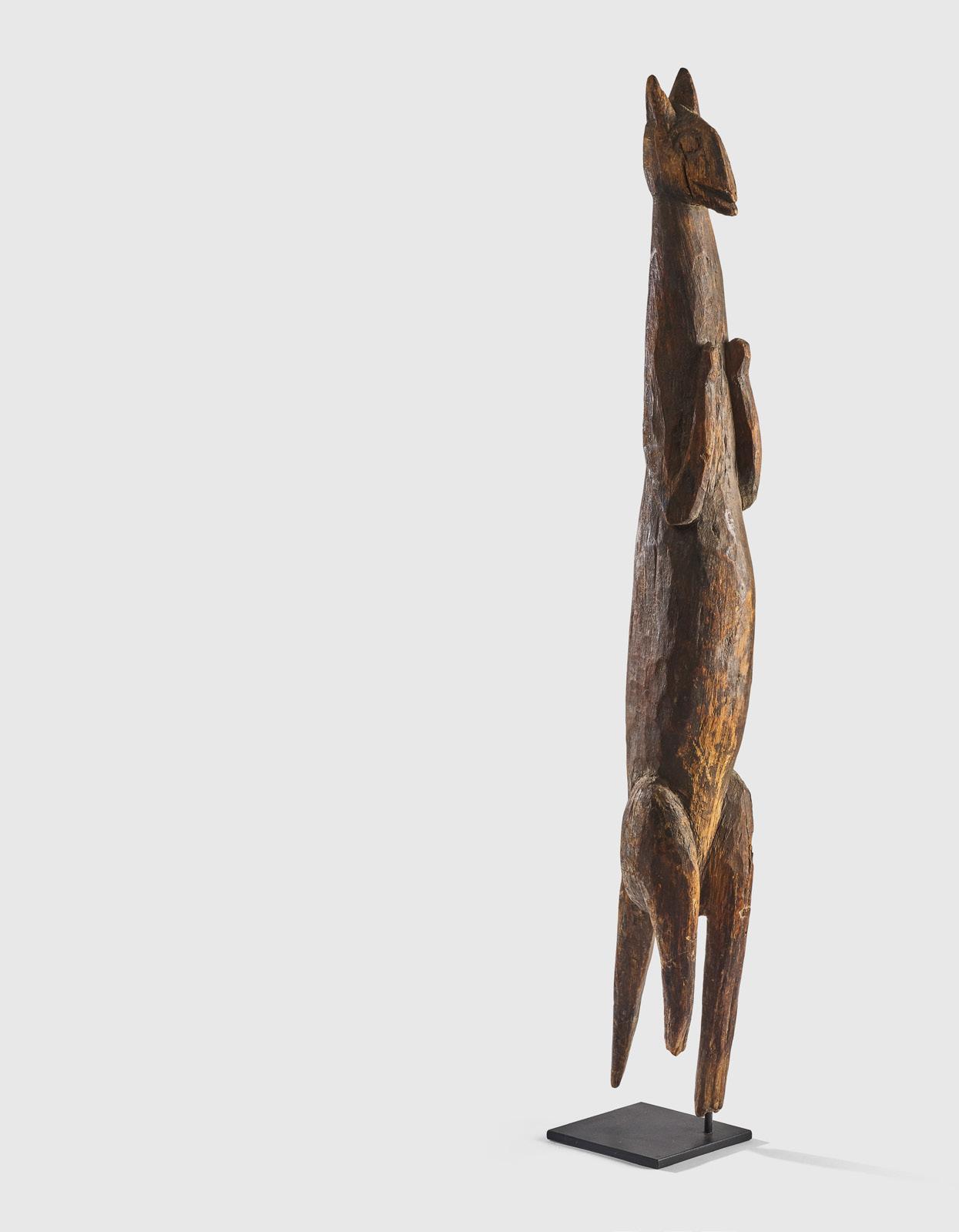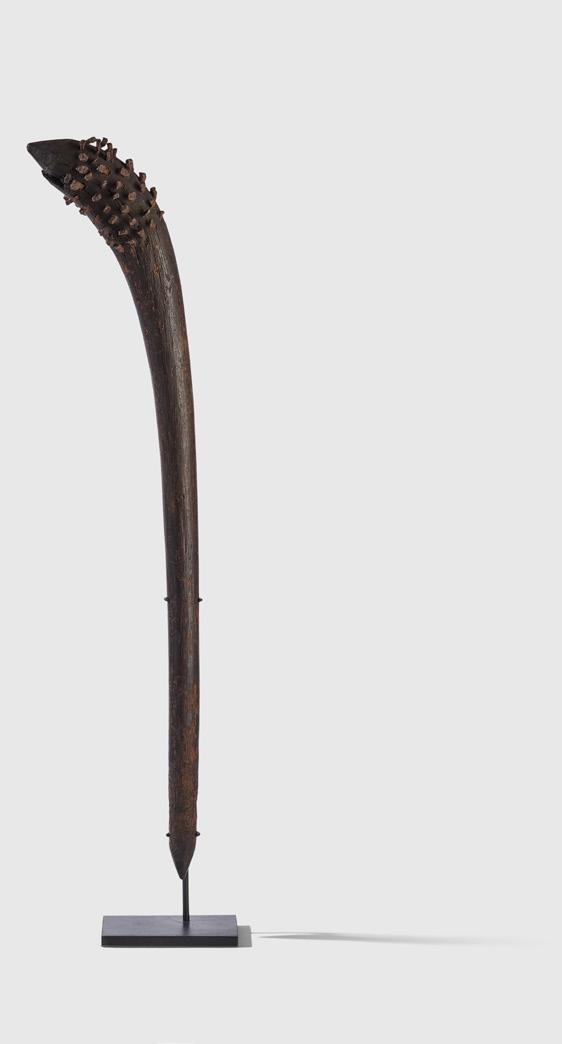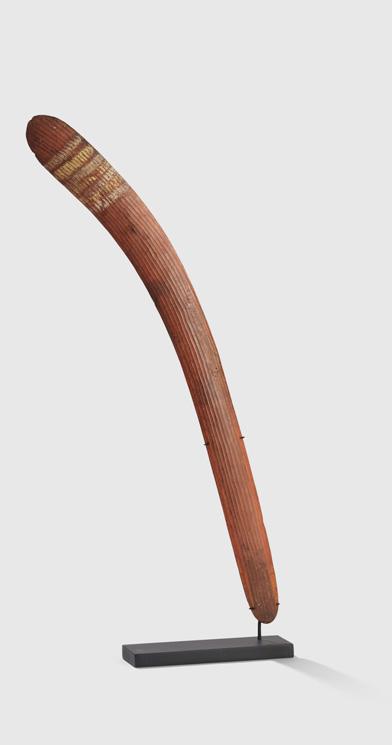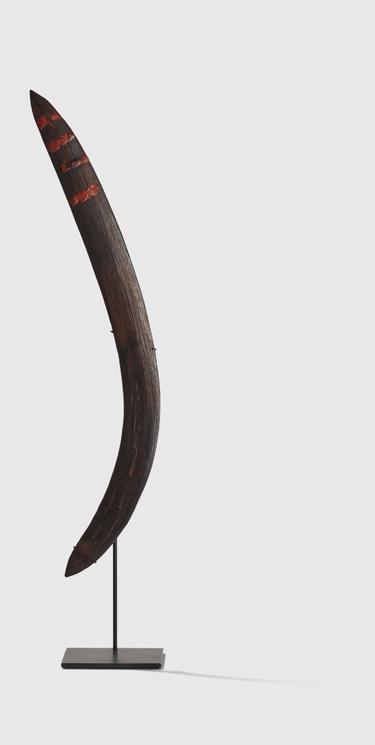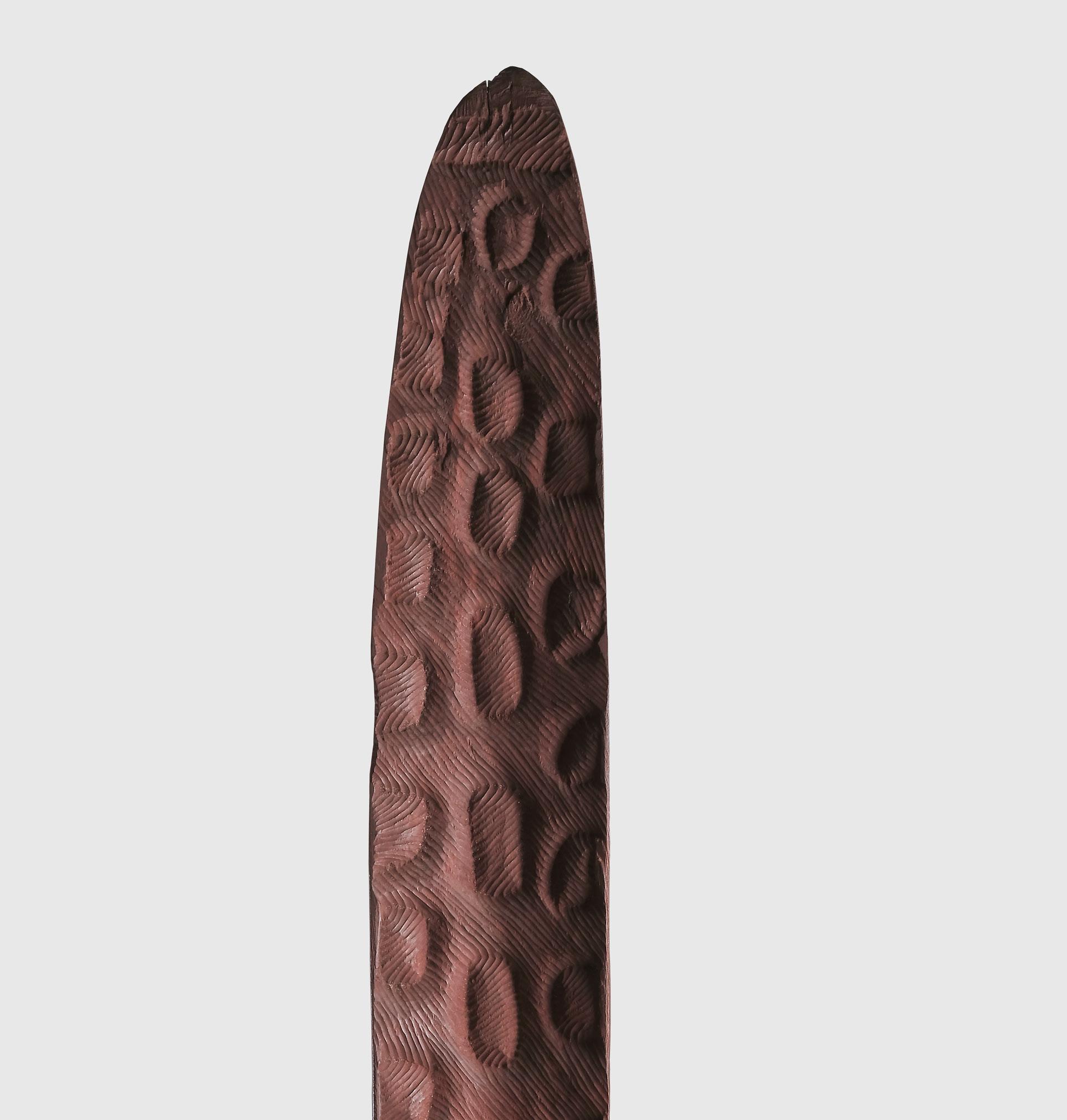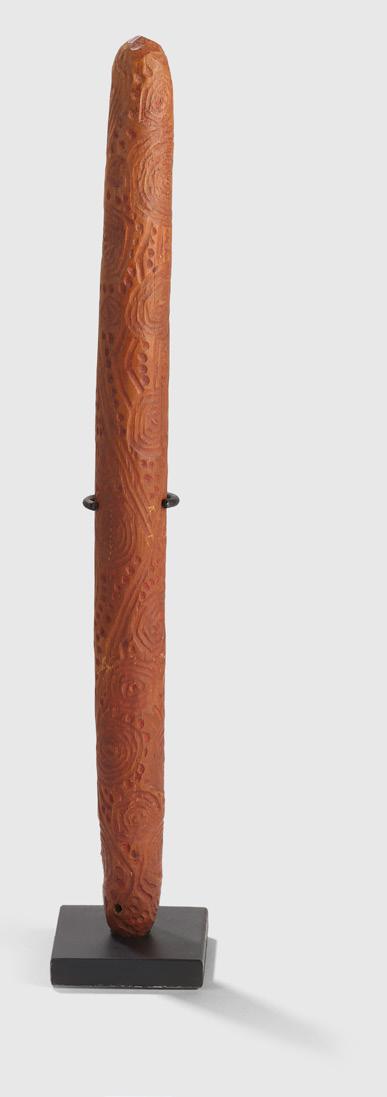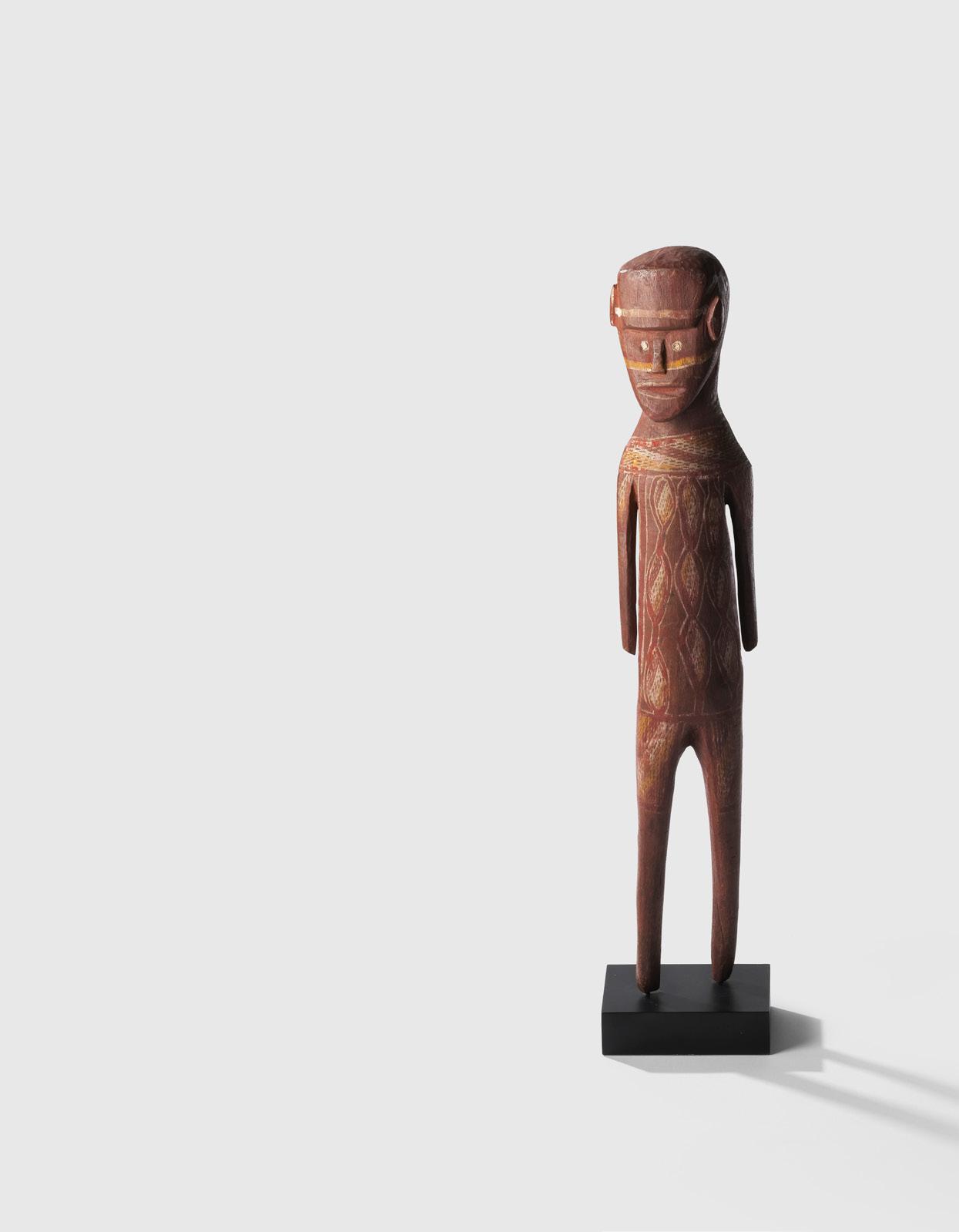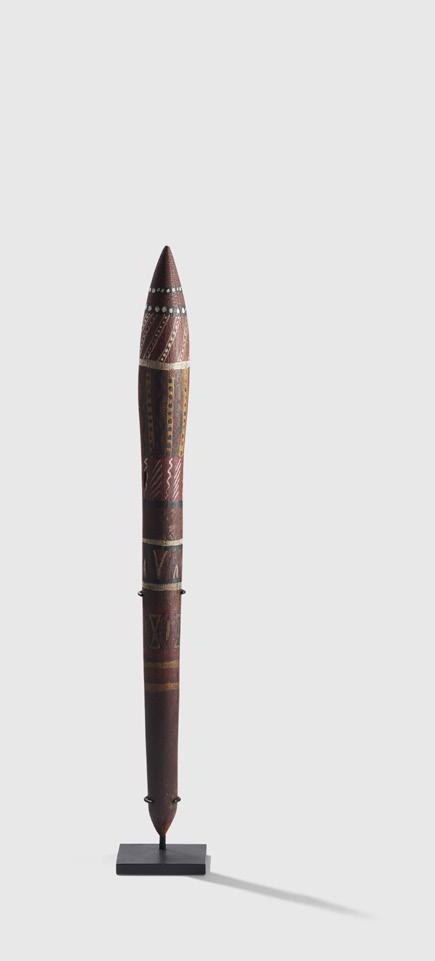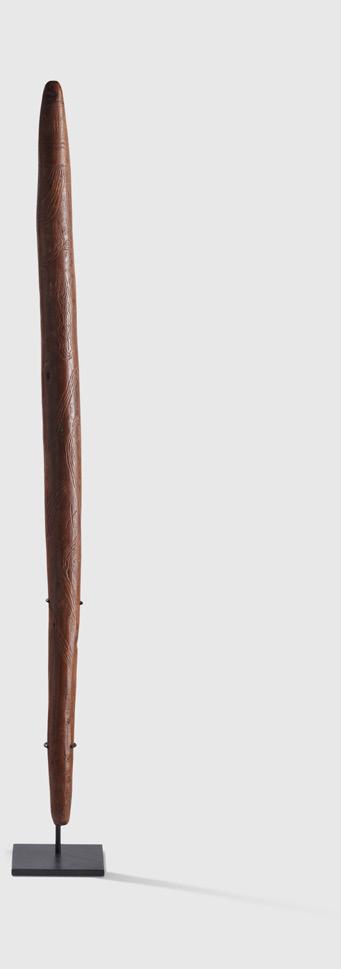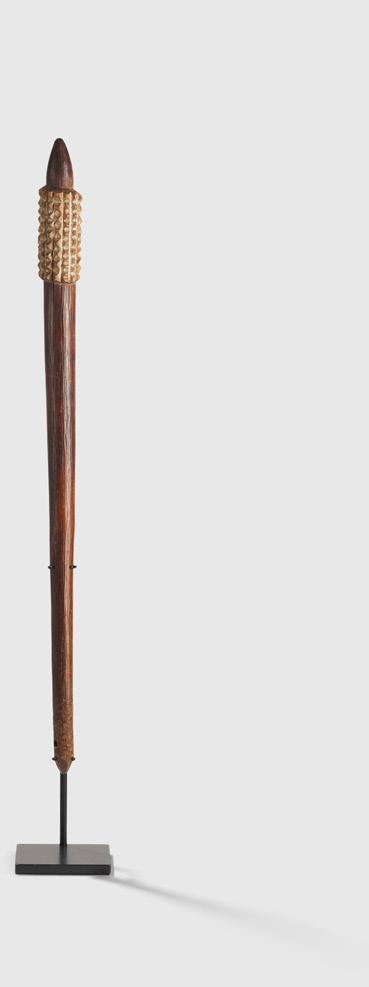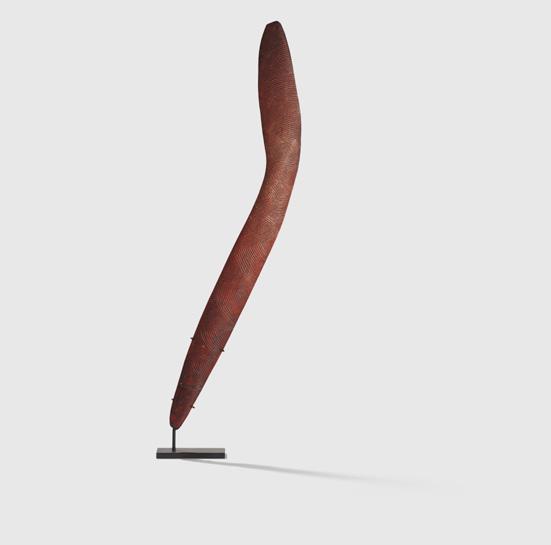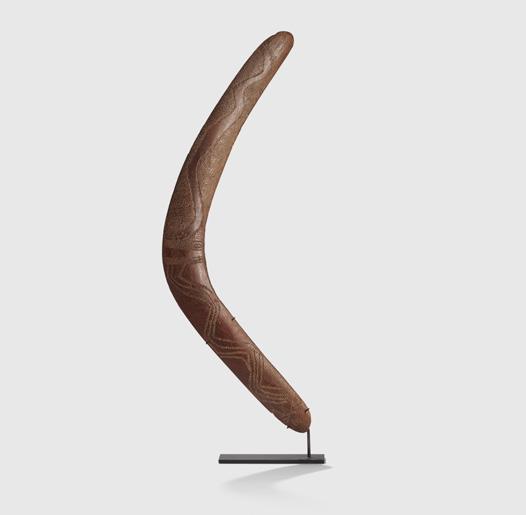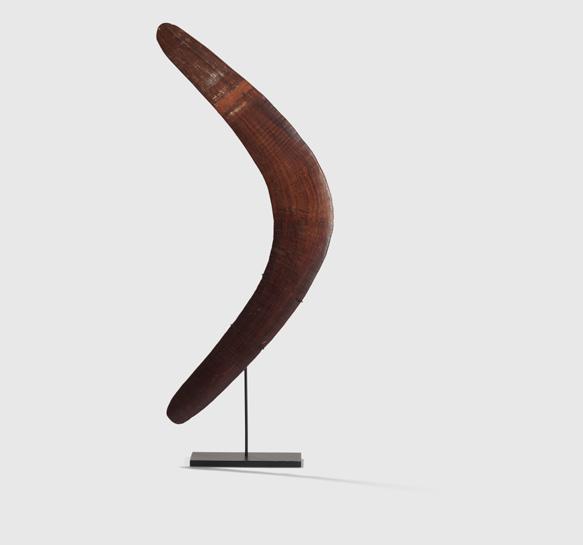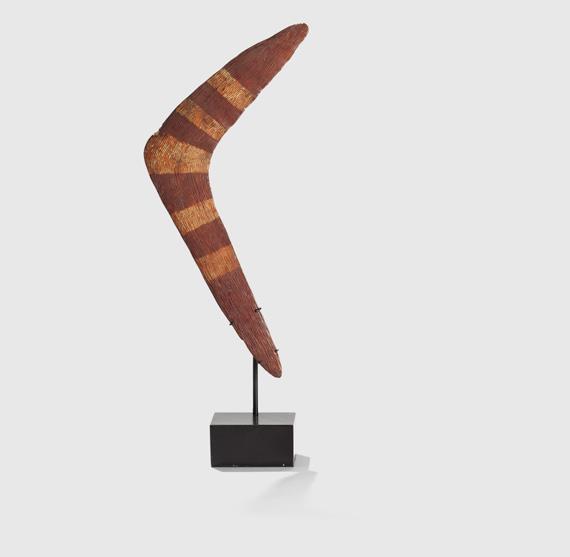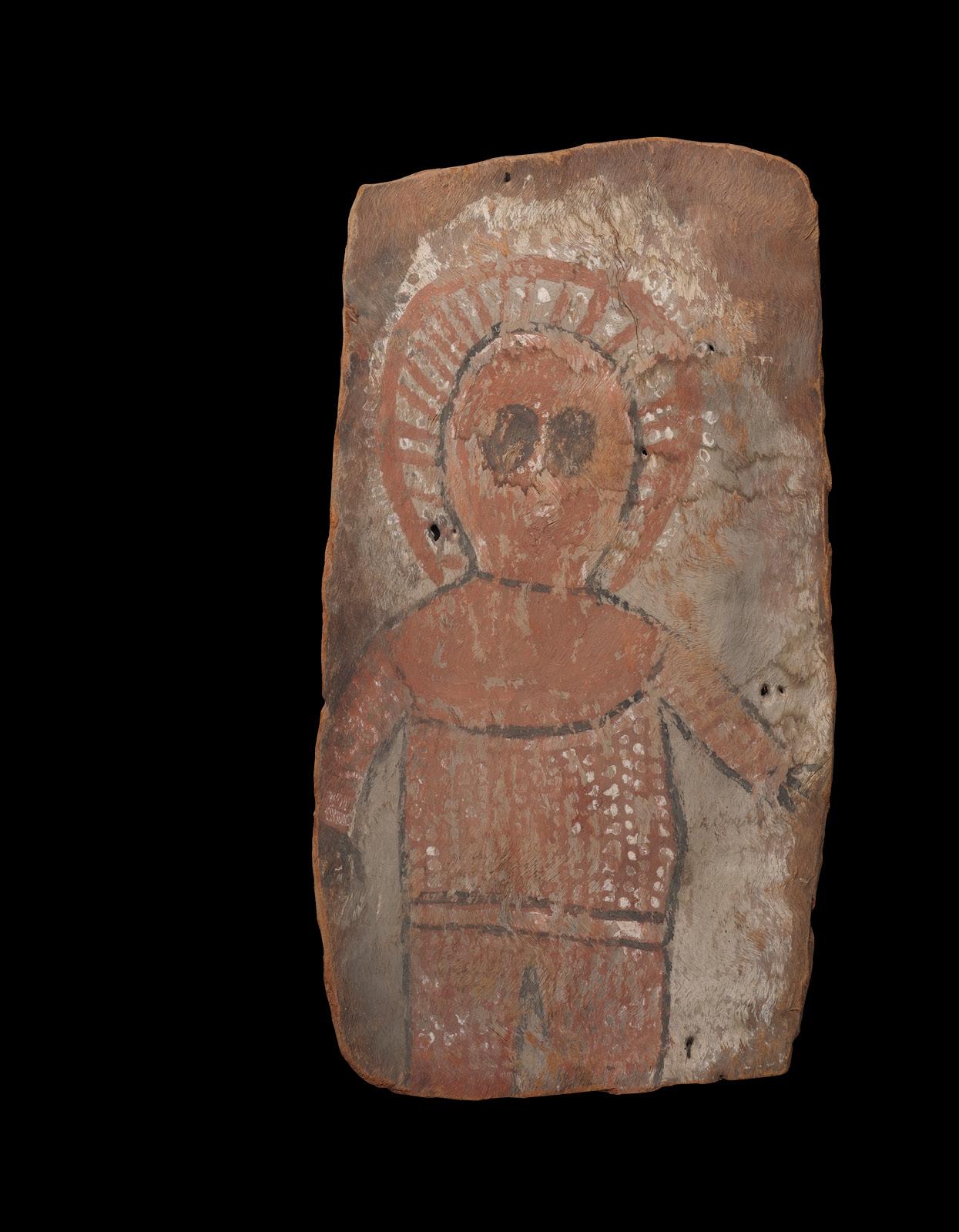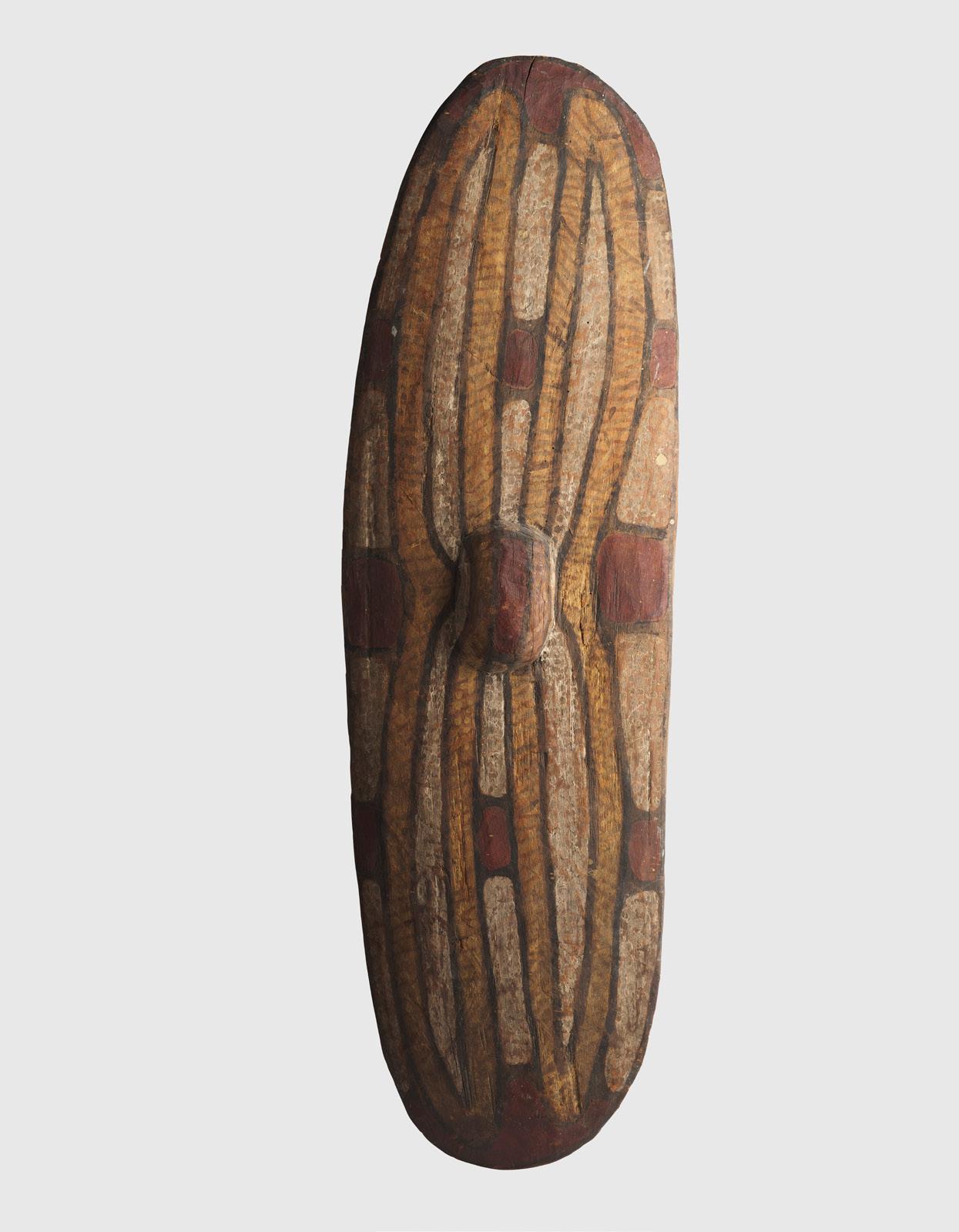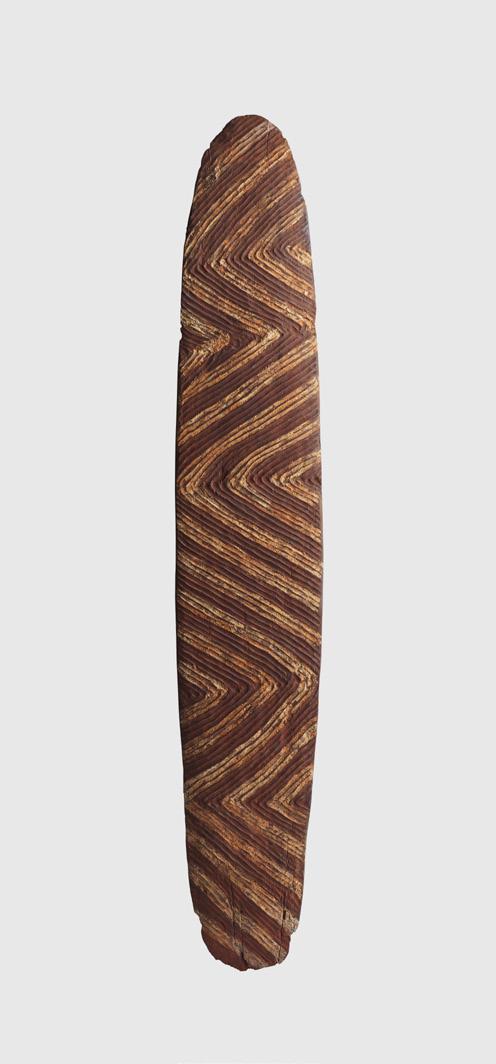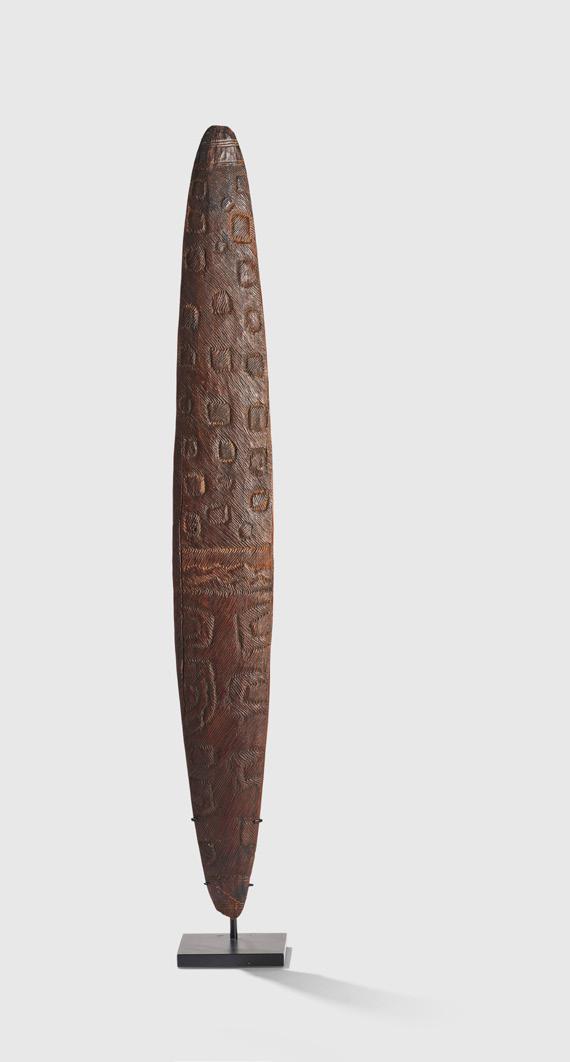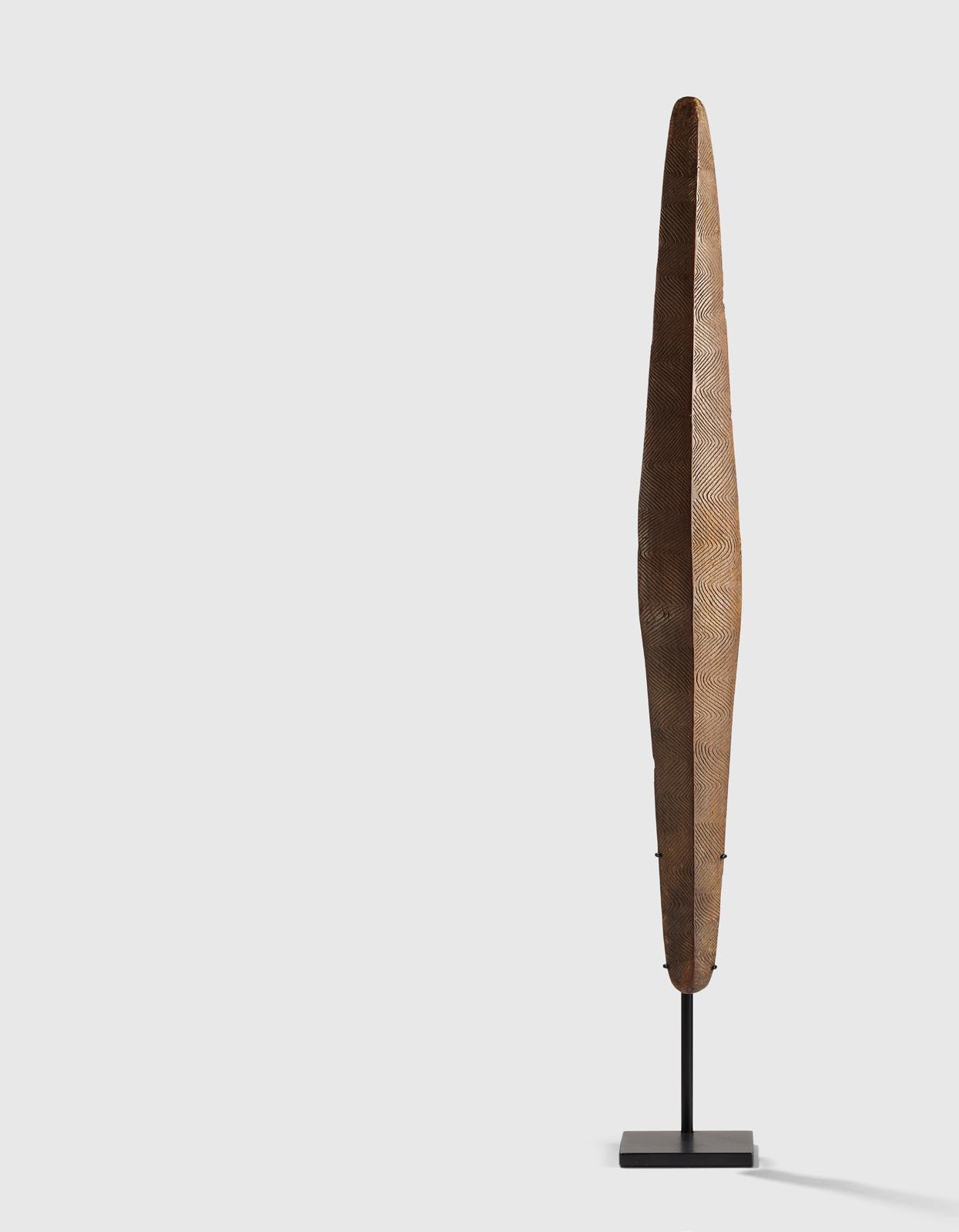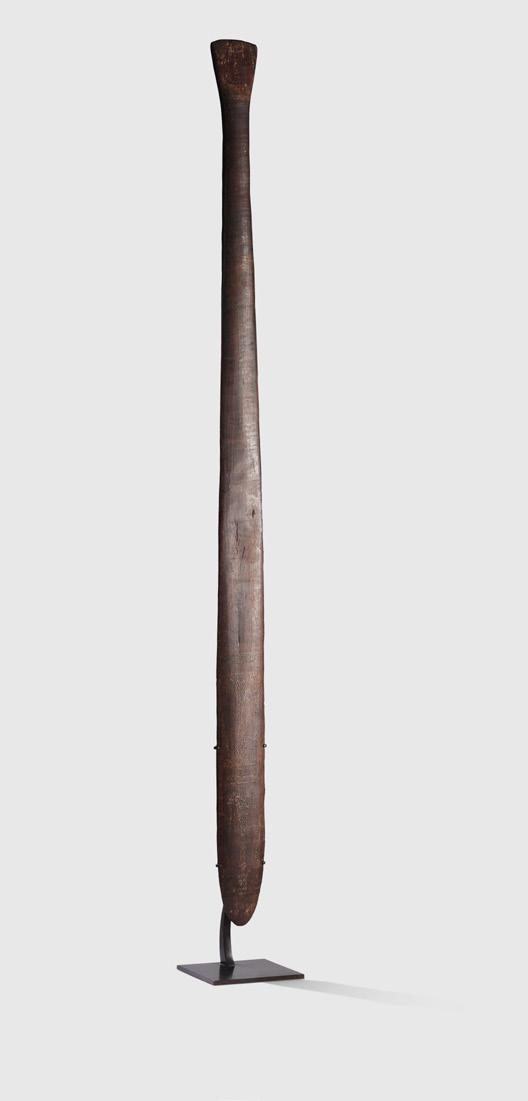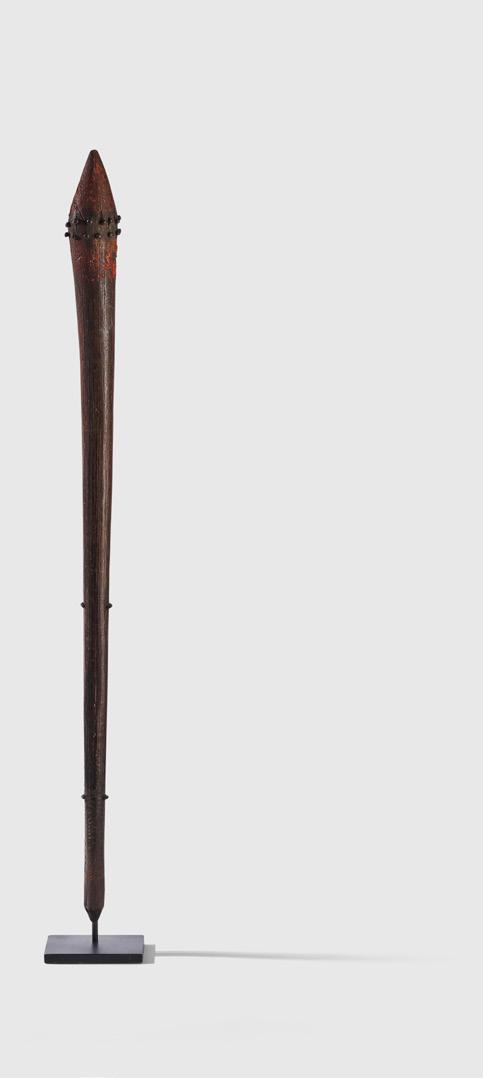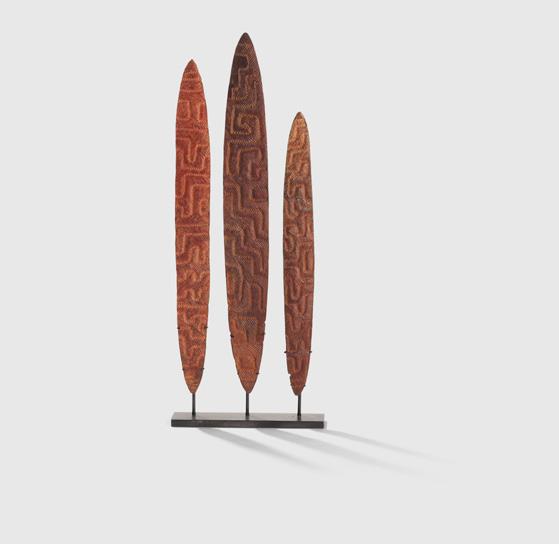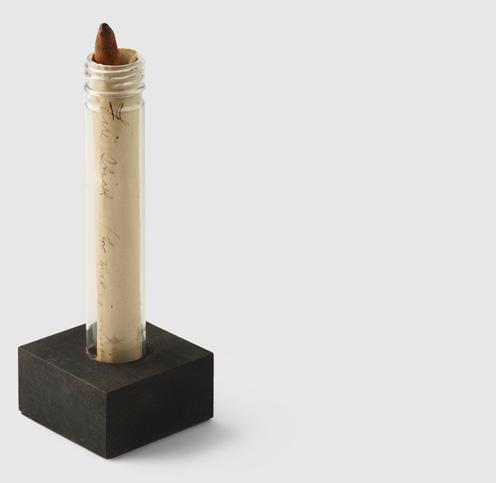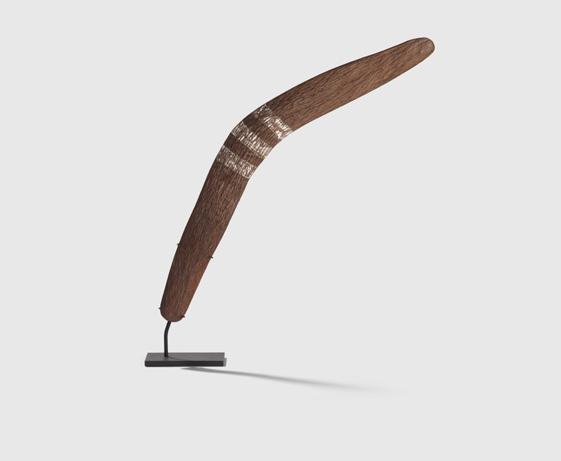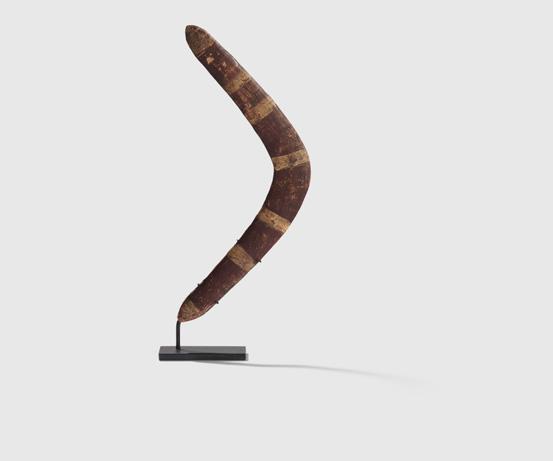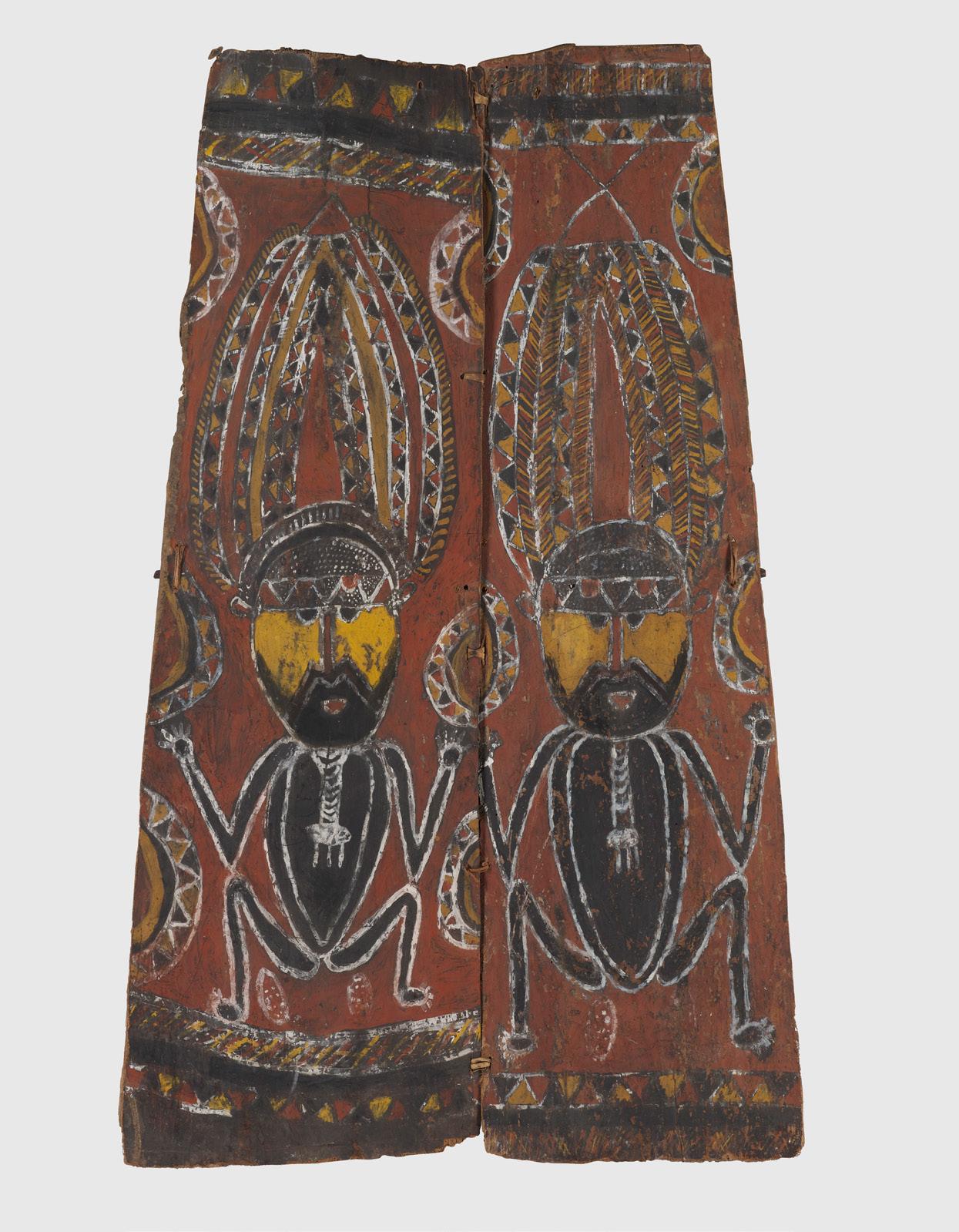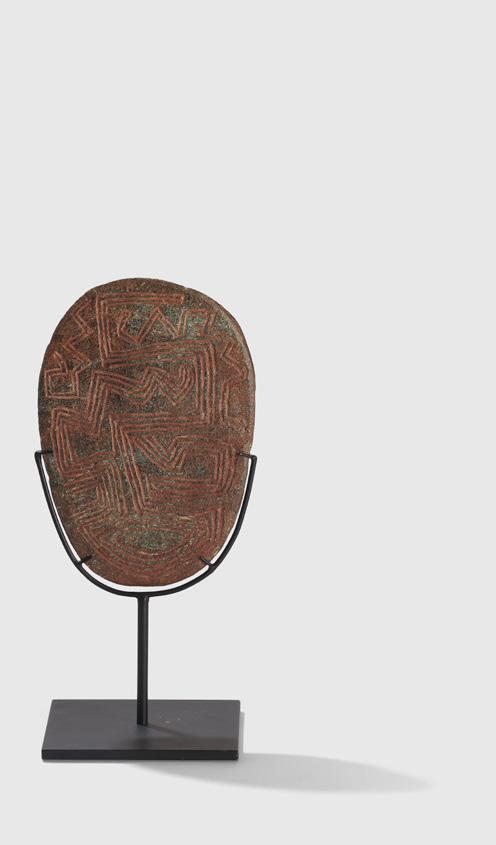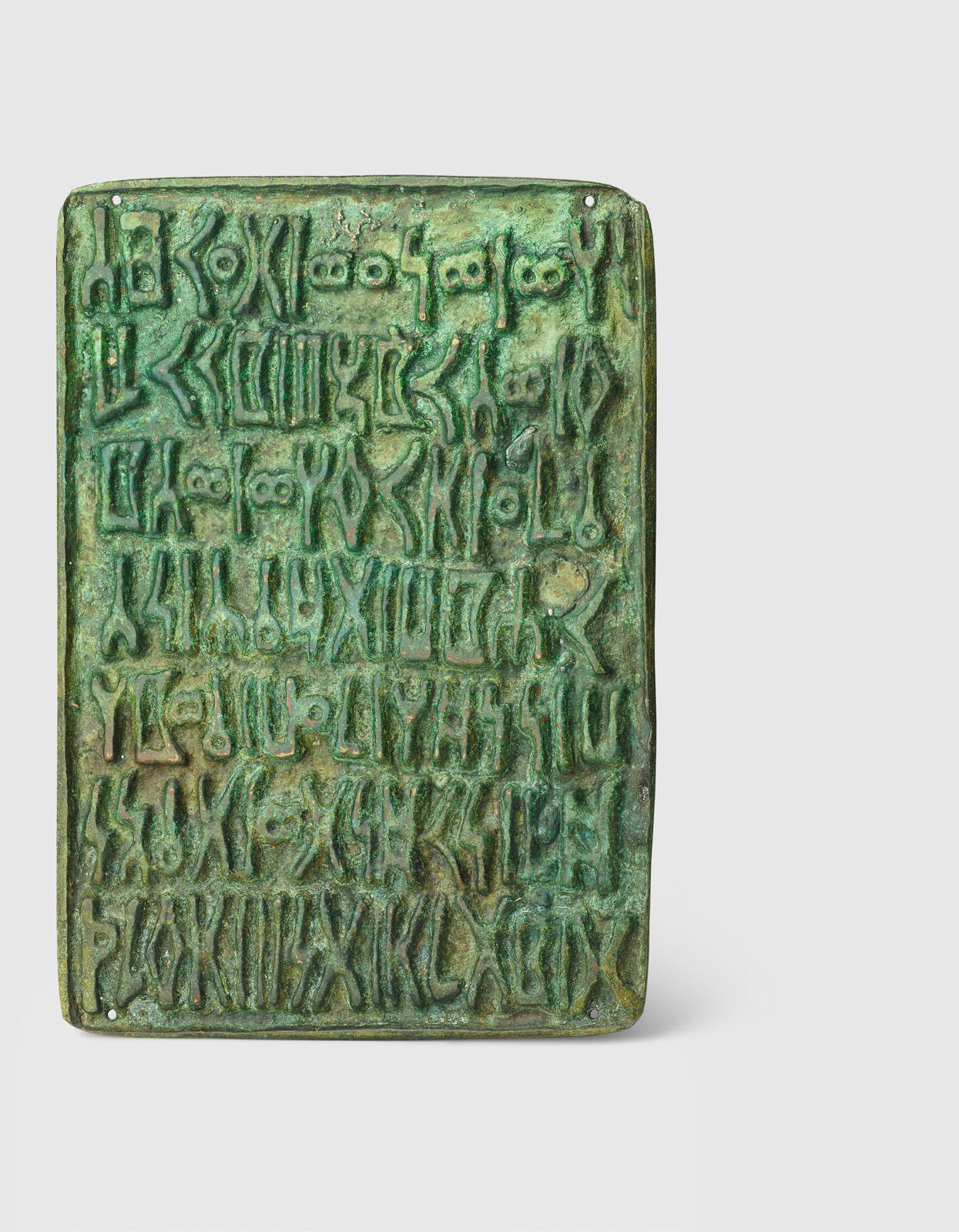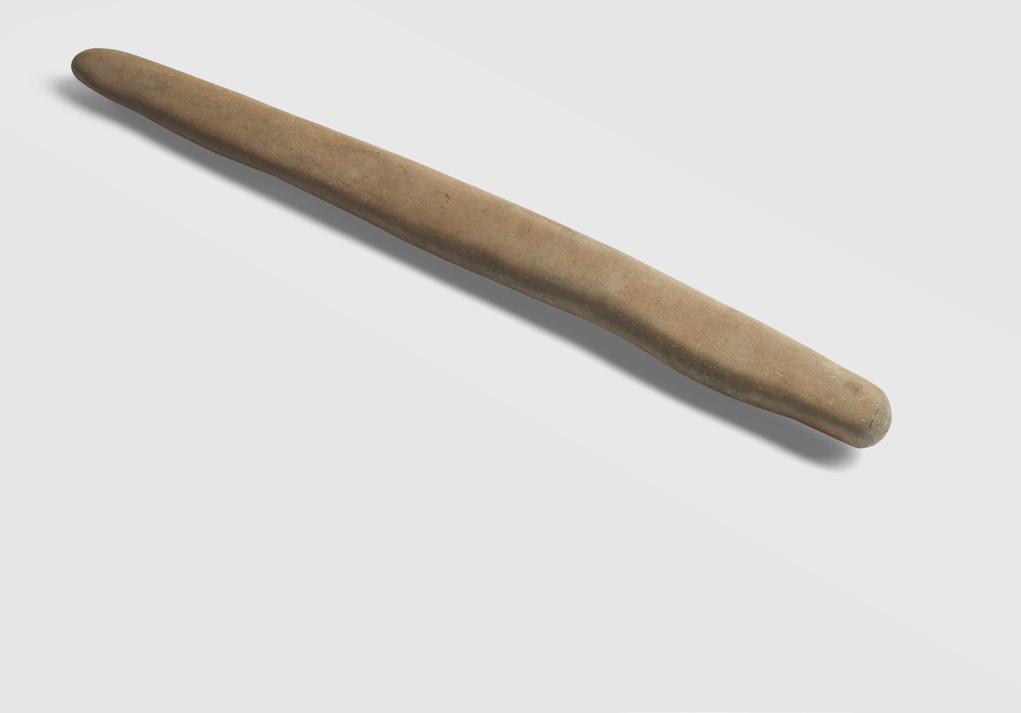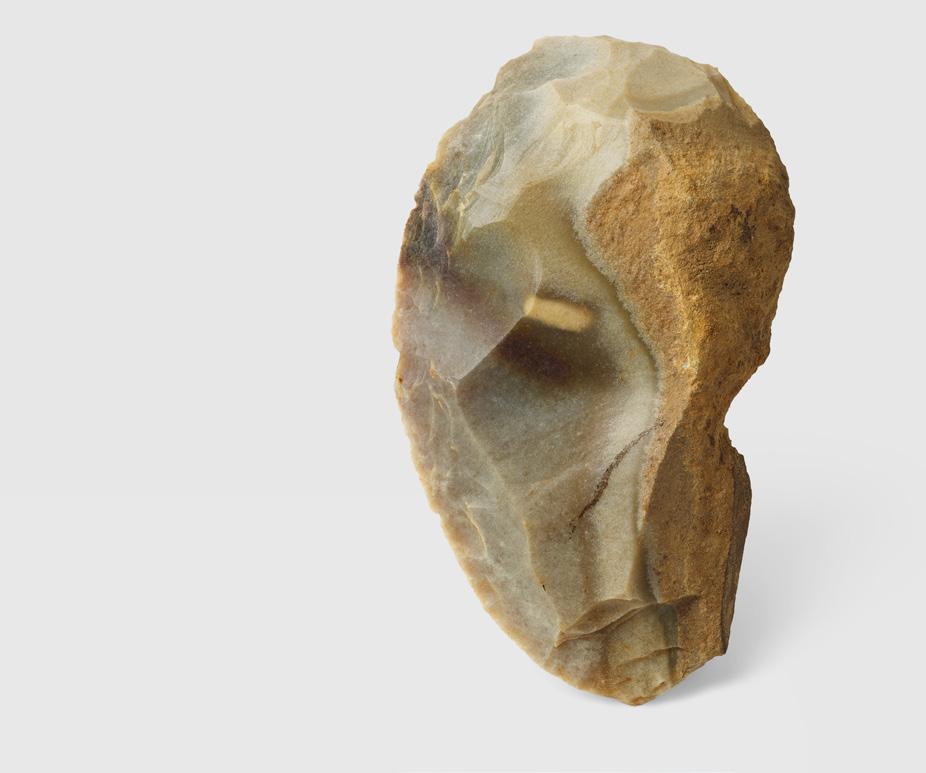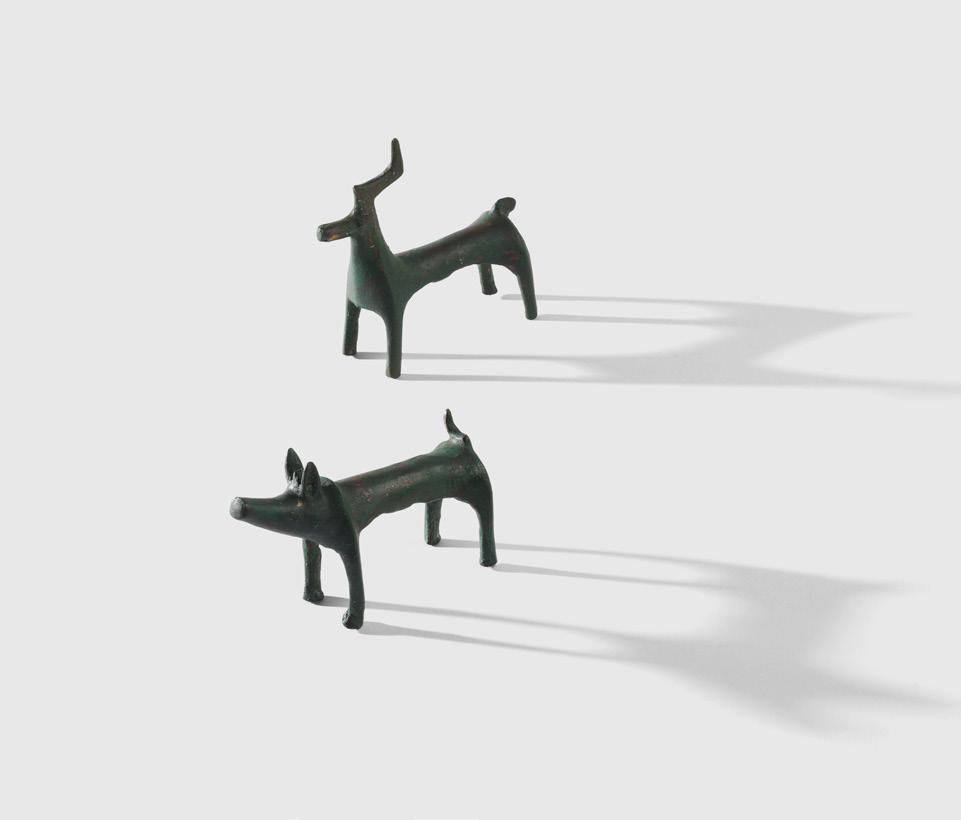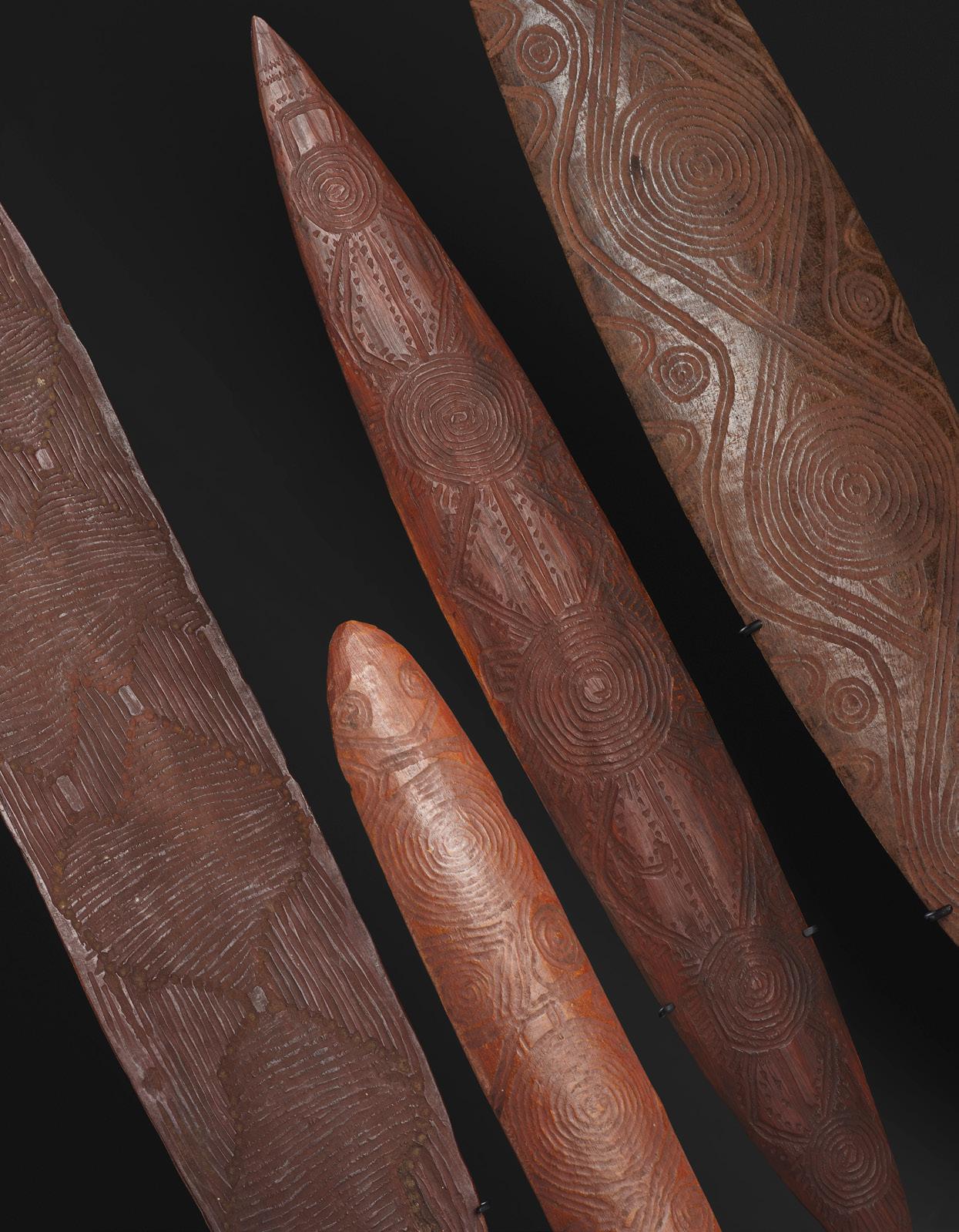THE COPPENS COLLECTION
The François Coppens Collection of Aboriginal Art represents over twentyfive years of passionate collecting and deep engagement with Australia’s First Nations cultural heritage. This carefully assembled collection brings together a wide range of works that reveal how artistry and meaning are deeply woven into every aspect of life and material culture.
At its heart lies an outstanding selection of shields from diverse regional traditions, alongside finely crafted woomeras, clubs, boomerangs and other objects distinguished by their balanced proportions, graceful contours and the harmonious integration of form and function. Complementing these are works of art that draw upon ancestral traditions while expressing the continuing vitality of First Nations creativity, including pieces by celebrated figures such as Dick Nguleingulei Murrumurra.
Together, the works assembled by François Coppens offer a well-rounded and insightful perspective on one of the world’s oldest and most profound artistic lineages. Aboriginal art is deeply connected to community and Country. Every object, whether a shield, boomerang or spearthrower, carries layers of meaning that link people to place, ancestors and living tradition. Designs and forms express knowledge of the land and the values that sustain it, turning practical tools into expressions of identity and belonging.
Making and using these objects reinforces shared knowledge and connection within communities, while also maintaining cultural memory across generations. Through this ongoing relationship between creativity, land and life, Aboriginal art continues to embody a living and enduring connection to Country.
We acknowledge the Traditional Custodians of the lands and waters across Australia from which the artists in this collection drew inspiration.
We pay our respects to their Elders past and present, and extend that respect to all Aboriginal and Torres Strait Islander peoples today.
Shields from across Australia show great diversity in form, design and meaning. Their shapes, materials and decorations varied between regions, reflecting local environments and cultural traditions. In the rainforests of Queensland, broad shields were carved from the buttress roots of fig trees and painted with bold totemic designs in natural pigments. In contrast, the smaller wunda shields of Western Australia were finely crafted and decorated with incised geometric patterns. In the south east, narrow hardwood shields were engraved with complex designs such as zigzags, chevrons, circles and spirals. These patterns often represented rivers, pathways or ancestral stories, linking the shield to Country and to the people who made and used it.
Making a shield required great skill and time. The process was highly valued, as the finished object carried both practical and symbolic importance. Shields were used in combat but also in ceremony and performance, expressing identity, strength and connection to ancestors. Their carved or painted surfaces could create optical effects in motion, enhancing the presence and agility of the warrior.
The decoration of shields also conveyed individuality and belonging. Each design reflected local knowledge and cultural meaning, while sharing visual links with body painting, carving and other ceremonial arts. Through their designs and craftsmanship, shields served not only as protective tools but also as powerful expressions of cultural identity and spirituality.
More than simple weapons, they embody the close relationship between people, place and creativity, uniting function, art and meaning.
SHIELD
WESTERN AUSTRALIA, POSSIBLY YAMAJI PEOPLE
carved wood and pigment, of elliptical form, the obverse engraved with fluting and featuring a serpent motif in black pigment against an ochre ground, the reverse with zig-zag fluting and an integral handle, raised on a bespoke mount designed for wall installation
71.1cm long
Provenance: Chris Boylan, Sydney François Coppens, Belgium
£2,500-3,500
SHEILD
WESTERN AUSTRALIA, POSSIBLY YAMAJI PEOPLE
carved wood and pigment, of elliptical form, the obverse engraved with fluting and featuring a motif of alternating ochre and black sweeping bands, the reverse with an integral handle, raised on a bespoke mount designed for wall installation
65.5cm long
Provenance: Erik Farrow, California, United States François Coppens, Belgium
£1,000-1,500
SHIELD
AUSTRALIA
carved wood and pigment, incised with linear and cross-hatched designs, overlaid with white pigment, an integral handle to the reverse, accompanied by a stand intended for wall mounting
64.5cm long
Provenance: Private collection, France
Private collection, Belgium
Native, Brussels, Tribal Art, Modern Art and 20th Century Furniture, January 27th 2018, lot 3
François Coppens, Belgium, acquired from the above
£2,000-3,000 11
SHIELD
WESTERN AUSTRALIA, POSSIBLY BARDI PEOPLES
carved wood and pigment, of elliptical form, the obverse with fine fluting and horizontal lines of white against an ochre ground, the reverse with an integral handle
65cm long
Provenance: De Zwaan, Amsterdam, Art and Antique Sale, 9th November 2021, lot 3513
François Coppens, Belgium
£2,000-4,000
SHIELD
AUSTRALIA
carved wood and pigment, of elongated oval form with rounded ends, the obverse adorned with a series of interlocking diamond motifs, dual perforations to top, with integral handle to reverse, accompanied by a stand intended for wall mounting
49cm long
Provenance: Chris Boylan, Sydney, Australia François Coppens, Belgium, acquired from the above £2,500-3,500
13
WUNDA SHIELD
AUSTRALIA
carved wood and pigment, of long elliptical form, decorated with zigzag patterns consisting of a series of longitudinal grooves divided into three sections, coloured with red and white ochre, accompanied by a backet for wall mounting
71cm long
Provenance: McCann Collection, Ottawa Michael Hamson, California François Coppens, Belgium, acquired from the above £3,000-5,000
14
SHIELD
WESTERN AUSTRALIA
carved wood and pigment, of elliptical form, the obverse engraved with fluting and displaying a centre painted motif in cream and orange pigment, the reverse with fluting and an integral handle, raised on a bespoke mount designed for wall installation
71cm long
Provenance: Christopher Thorpe, Sydney
François Coppens, Belgium
£2,000-3,000
15
WUNDA SHIELD
WESTERN AUSTRALIA
wood and pigment, of long elliptical form, decorated with zigzag motifs composed of a series of longitudinal grooves divided into three sections, coloured with red and white ochre, the reverse adorned with vertical bands arranged in nine sections and bordered by horizontal grooves, fine patination and wear to the handle indicative of use, accompanied by a bespoke mount for wall display
85cm tall
Provenance: Private collection, Northern Australia
Chris Thorpe, Sydney
François Coppens, Belgium, acquired from the above
£5,000-8,000
Lot 8 (reverse)
Lot 13 (reverse)
Lot 9 (reverse)
Lot 14 (reverse)
Lot 10 (reverse)
Lot 15 (reverse)
Lot 11 (reverse)
Lot 16 (reverse)
Lot 18 (reverse)
Lot 24 (reverse)
Lot 19 (reverse)
Lot 25 (reverse)
Lot 20 (reverse)
Lot 26 (reverse)
Lot 28 (reverse)
Lot 22 (reverse)
17
NARROW SHIELD
WESTERN DESERT, AUSTRALIA
carved wood, of elongated oval form, covered with an ornate composition of engraved concentric squares, with an integral handle to the reverse and painted zig-zag decoration, accompanied by a bracket for wall mounting
82.8cm long
Provenance: Private collection, Australia François Coppens, Belgium
£4,000-6,000
PARRYING
SHIELD
WESTERN AUSTRALIA
carved wood and natural earth pigments, elongated oval shield, the obverse decorated with red ochre, vertical fluting and incised diagonal striations arranged in broad bands, the reverse with square and line engraving and unadorned with red ochre, accompanied by a bracket for wall mounting
83.2cm long
Provenance: D’lan Davidson, Sydney, Australia François Coppens, Belgium, acquired from the above
£4,000-6,000
SHIELD
KIMBERLEY, AUSTRALIA
carved wood and pigment, he elongated, slightly convex form tapers towards both ends, the front decorated with alternating bands of diagonal hatching and cross-hatching in ochre and white pigment, with integral handle to reverse, accompanied by a bracket intended for wall mounting
71cm long
Provenance: Michael Hamson, California, United States
François Coppens, Belgium
£3,000-5,000 19
PARRYING SHIELD
WESTERN AUSTRALIA
carved wood, of elongated oblong form, adorned with horizontal bands of alternating etched designs, with integral handle to reverse, rich patination, accompanied by a mount for wall installation
84.6cm long
Provenance: Marc and Elaina Pinto, Perth, Australia
François Coppens, Belgium
£3,000-5,000
20
SMALL RAINFOREST SHIELD
QUEENSLAND
carved wood and pigment, of oval form, with central projecting boss, the surface decorated with geometric designs in natural pigments of red, white and brown, the reverse with integral handle 48.8cm long
Provenance: François Coppens collection, Belgium, acquired Mossgreen Auction House, Sydney, 2009
£2,000-4,000
21
SMALL RAINFOREST SHIELD
QUEENSLAND
carved wood and pigment, the obverse adorned with geometric patterning, with an integral handle to the reverse 32cm long
Provenance: Woolley and Wallis Auctioneers, Salisbury, 1st March 2017, African and Oceanic Art, lot 523
£1,000-1,500
RAINFOREST SHIELD
QUEENSLAND, AUSTRALIA
carved fig root and pigment, of classic kidney form, with central protruding boss, adorned with a geometric design composed of intersecting linear elements forming lozenge motifs, rendered in red and white natural pigments against the darkened ground, the reverse is plain, with an integral handle 85.7cm long
Provenance: Marc and Elena Pinto, Australia François Coppens, Belgium, acquired from the above
Note: For a similar example, please see The Melbourne Museum, Australia, accession number 45144
£20,000-30,000
24
PAINTED SHIELD
NORTHERN TERRITORY, AUSTRALIA
painted and carved wood, of oval form, adorned with longitudinal grooves, the obverse with an all-over red pigment and central black stripe with white border, integral handle to the reverse, accompanied by a bracket intended for wall mounting
64cm long
Provenance: Christopher Thorpe, Sydney, Australia
François Coppens, Belgium
£800-1,200
PAINTED SHIELD
AUSTRALIA
carved wood and pigment, of elongated oval form, the surface finely incised with longitudinal grooves, red, black and white decoration to obverse, integral handle to reverse, accompanied by a bracket intended for wall mounting
62cm tall
Provenance: François Coppens, Belgium
£700-900
PAINTED SHIELD
NORTHERN TERRITORY
carved wood and pigment, of elongated oval form, the surface finely incised with longitudinal grooves, red, black and white decoration to obverse, integral handle to reverse 64.5cm tall
Provenance: Private collection, Australia
Woolley and Wallis Auctioneers, Salisbury, United Kingdom, Arts of Africa, Oceania and the Americas, 21st September 2023, lot 1735
François Coppens, Belgium, acquired at the above
£400-600
PAINTED SHIELD
CENTRAL DESERT, AUSTRALIA
carved wood, natural earth pigments and feathers, decorated with three concentric circular motifs in relief, alternating with vertical lines, accompanied by a bracket intended for wall mounting 69cm long
Provenance: Christopher Thorpe, Sydney, Australia
François Coppens, Belgium
£1,200-1,800
28
SHIELD
CENTRAL AUSTRALIA
carved wood and pigment, convex oval, the obverse with deeply incised vertical fluting and painted decoration in red, white and black pigments
66cm long
Provenance: François Coppens collection, Belgium, acquired Mossgreen Auction House, Sydney, 2009
£1,000-1,500
SHIELD WITH ENGRAVED DESIGN
AUSTRALIA
carved hardwood, of oval, convex form, adorned with engraved designs, dark patina, accompanied by a bracket for wall mounting 47.2cm tall
Provenance: Franck Marcellin, Aix-en-Provence, France, 2010s François Coppens, Belgium, acquired from the above
£2,500-3,500
A PAIR OF HOOKED BOOMERANG
LIKELY WARLPIRI PEOPLES, NORTHERN TERRITORY, AUSTRALIA
carved wood and ochre, each adorned with incised grooving and raised together on a bespoke mount (2) longest 72cm
Provenance: Chris Boylan, Sydney, Australia François Coppens, Belgium
Note: Boomerangs such as the present examples (known as a “number seven” on account of the shape), were primarily crafted by the Tanami desert peoples but circulated widely across central and northern Australia through extensive inland trade networks. While mainly used in combat, they were also effective for bird hunting, as they could knock birds from flocks in flight, making them easier to catch. Like most Aboriginal boomerangs, they did not return when thrown.
For similar please see: The Metropolitan Museum, New York, accession number 1979.206.1667.
£1,200-1,800
30
BOOMERANG
WESTERN AUSTRALIA
carved wood and earth pigments, of typical curved and tapered form, with fine vertical fluting throughout, raised on a bespoke mount 62.5cm long
Provenance: François Coppens, Belgium, acquired on the European art market
£600-900
31
LIL-LIL CLUB
SOUTH-EAST AUSTRALIA
carved wood, with a subtly curved handle and triangular striking head, raised on a bespoke mount
62cm long
Provenance: The Monarch Historical Museum, Newcastle
Private collection, Queensland, Australia
D’lan Davidson, Sydney Australia
François Coppens, Belgium, acquired from the above
Note: The lil-lil is a club made and used only in south-eastern Australia. It was a powerful weapon in battle, able to strike and cut at enemies even when they carried a heavy wooden shield called a mulga. Expert fighters could also throw the lil-lil like a boomerang.
£2,000-3,000
32
BULBOUS CLUB
VICTORIA, AUSTRALIA
carved wood, with rounded bulbous striking head tapering to a narrow handle with incised grip, rich patination, raised on a bespoke mount
67cm long
Provenance: Marc Pinto, Perth, Australia François Coppens, Belgium
£400-600
33
WOOMERA
AUSTRALIA
carved wood, the lance-arm curved in form with a hook extension at one end and a slender shaft continuing to the counterbalancing end, raised on a bespoke mount
77cm long
Provenance: Lempertz, Brussels, African and Oceanic Art, 5th April 2017, lot 254, achieved 1,364 €
£400-600
The spearthrower is another remarkable example of Aboriginal innovation. It works by extending the thrower’s arm, allowing spears to be launched with greater speed and accuracy. Designs varied depending on local materials and needs, and the tool often had multiple uses, such as digging, cutting, or scraping. Spearthrowers were sometimes decorated with carvings or paintings, showing personal or cultural meanings. They were not only practical tools but also important ceremonial and symbolic objects, representing skill, identity, and status. These tools show how everyday objects could hold deep cultural significance, linking survival skills with creativity and spiritual life.
34
WOOMERA
WESTERN AUSTRALIA
carved wood, of oval form, with deep linear carved geometric decoration accented with pigment, gum resin handle and kangaroo tooth hook, raised on a bespoke mount
84.5cm long
Provenance: François Coppens, Belgium, acquired on the European art market
£1,000-1,500
35
WOOMERA
WESTERN AUSTRALIA
carved wood, of elongated leaf-shaped form with steep shoulders leading to a subtly convex face tapering to a narrow handle with rounded gum terminal, the surface is finely engraved with a continuous herringbone pattern composed of alternating diagonal lines, with a red ochre wash, raised on a bespoke mount
78.8cm long
Provenance: François Coppens, Belgium, acquired on the European art market
£800-1,200
PAINTED WOOMERA
WESTERN AUSTRALIA
carved wood, pigment, vegetal fibre and gum resin, adorned with engraved zig-zag motifs, the surface is decorated with an abstract figural design executed in red, white and black pigment, gum applied to base of handle, raised on a bespoke mount
81cm tall
Provenance: Michael Hamson, California, United States François Coppens, Belgium, acquired 2019
£3,000-5,000 37
WOOMERA
WESTERN AUSTRALIA
carved wood, of elongated elliptical form, with deep linear carved geometric decoration, gum resin handle and possum tooth hook, raised on a bespoke mount
86.7cm long
Provenance: François Coppens, Belgium, acquired on the European art market
£600-900
WOOMERA AUSTRALIA
carved wood, fibre and tooth, the body displaying engraved chevron and line motifs across both faces, the distal end with fibre binding holding a kangaroo tooth, raised on a bespoke mount
67cm long
Provenance: François Coppens, Belgium, acquired on the European art market
£1,200-1,800
39
WOOMERA
RABY BAY, QUEENSLAND, AUSTRALIA
carved wood, of oval form, with deep linear carved geometric decoration, gum resin handle and possum tooth hook, with a lightly carved and ink filled inscription reading:
”…S.J. Rakes, Raby Bay 2 May 1901 raised on a bespoke mount
53.5cm long
Provenance: Acquired in situ at Raby Bay, Queensland, 2nd May 1901 François Coppens, Belgium, acquired on the European art market
Note: Aboriginal communities throughout Australia traditionally utilised spear throwers for both hunting and combat. To use the device, the handle at its lower end was gripped while a small, hooklike extension at the upper end engaged with the hollow base of a long, lightweight spear. This tool functioned by effectively extending the user’s arm, providing a mechanical advantage that boosted the spear’s speed and throwing range. While spear throwers could allow a hunter or warrior to strike a target from up to eighty yards away, users typically aimed to get as close as possible to maximise the force and precision of their throw.
£400-600
CHURINGA AUSTRALIA
carved wood, finely incised with concentric circle and linear designs arranged in a symmetrical composition along both faces, the end tapering to rounded points, raised on a bespoke mount
48.8cm long
Provenance: François Coppens, Belgium, acquired on the European art market
£800-1,200
41
CHURINGA
CENTRAL AUSTRALIA
carved wood, of elliptical form with incised geometric decoration, raised on a bespoke mount
29cm long
Provenance: François Coppens, Belgium, acquired on the European art market
£700-900
42
WOODEN CHURINGA AUSTRALIA
carved wood, elongated oval with pointed ends, with incised linear and zigzag designs and dark patination, raised on a bespoke mount
41.4cm long
Provenance: François Coppens, Belgium, acquired on the European art market
£1,000-1,500
DICK NGULEINGULEI MURRUMURRA (1920
1988)
MIMI SPIRIT AND KANGAROO, C. 1970S
natural earth pigments on eucalyptus bark, depicting a Mimi spirit hunter and kangaroo
94.5 x 56cm
Provenance: Jerome Gould, Los Angeles
Michael Hamson, California
François Coppens, Belgium
Note: Dick Nguleingulei Murrumurru was a significant Bularlhdja artist from Western Arnhem Land, born around 1920 at Kukadjerri near the Liverpool River. He grew up within the rock country that shaped his art, absorbing the visual traditions of ancient stone painting sites that his bark paintings later carried forward.
Murrumurru’s work is celebrated for its fidelity to the rock art heritage of his homeland. While many of his contemporaries adopted new influences, he remained devoted to traditional forms and ceremonial imagery. His paintings on eucalyptus bark are executed with natural ochres, often set against a rich red ground that heightens the brightness of the white and yellow figures. He is best known for his masterful use of the Western Arnhem Land x-ray style, depicting animals, spirits and ancestral beings with visible internal anatomy. Figures are outlined in white pipeclay, their faces marked by large open mouths and high-set eyes; features that give his ancestral subjects a powerful and animated presence.
Working predominantly in the 1960s - 70s, he became known as one of the great custodians of the old painting traditions. His barks, now held in major institutions around the world, act as a bridge between the rock art of the region and the modern bark painting movement of Arnhem Land.
£2,000-3,000
LARGE WALLABY FIGURE
AUSTRALIA
carved wood, a tall attenuated sculpture of a wallaby, depicted in an abstracted manner, the elongated body tapering smoothly into simplified limbs, with the head retaining an almost totemic expression, raised on a bespoke mount 104cm tall
Provenance: Alex Philips, Melbourne, Australia Michael Hamson, California, United States François Coppens, Belgium, acquired from the above £3,000-5,000
A PAIR OF TIWI SPEAR HEADS
TIWI PEOPLES, MELVILLE ISLANDS, AUSTRALIA
carved wood and pigment, each with raised geometric ridging and alternating painted sections in ochre, white and black pigments, raised together on a bespoke mount longest 95cm
Provenance: François Coppens, Belgium, acquired on the Belgian art market 2000s
£500-700
WAR CLUB QUEENSLAND
carved wood and metal, the long club broadening towards the head and tapering to a sharp point, the surface fluted along its length, the handle scoured for grip, the head slanting off to the side and inset with seven rows of nails, mounted on a bespoke stand
66.4cm long
Provenance: François Coppens, Belgium, acquired on the European art market
£1,000-1,500
BOOMERANG
AUSTRALIA
carved wood and pigment, a large example, displaying a subtle taper, with vertical fluting throughout, painted bands in white and yellow to one end, raised on a bespoke mount
75.5cm long
Provenance: François Coppens, Belgium, acquired on the European art market
£500-800
48
BOOMERANG
KIMBERLEY, WESTERN AUSTRALIA
carved wood and pigment, of typical form, adorned with engraving, red and white pigment, raised on a bespoke mount
61.5cm long
Provenance: The present boomerang is said to have been presented to Mr Carl Bowdewins of the Forrest River Mission by Chief King Peter in the late 1920s or early 1930s. The carvings are believed to symbolise the events of the Forrest River Massacre (also known as the Oombulgurri Massacre), a tragic episode in 1926 in which several Aboriginal people from the region were killed by police and civilians following the death of a pastoralist. A subsequent Royal Commission (1927) found evidence that at least eleven Aboriginal men and women were murdered and their remains destroyed. The area surrounding the Forrest River Mission was home to a number of Aboriginal families whose histories are partially preserved in mission and government archives. One such record refers to a “King Peter”, described as King David (Mudjuwanba)’s eldest son and a member of the Evans family. He is noted as having captained the local cricket team in 1929. It is possible that this individual is the same “Peter” who presented the boomerang to Mr Bowdewins.
£1,500-2,500
49
LARGE PAINTED BOOMERANG
SOUTH-EAST QUEENSLAND, AUSTRALIA
carved wood and pigment, of typical curved and tapered form, dark patination, fluting throughout, with four red stripes painted to the top, raised on a bespoke mount
63cm long
Provenance: Private collection, Melbourne, Australia
D’lan Davidson, Sydney, Australia
François Coppens, Belgium, acquired from the above
£1,000-1,500
PAINTED CHURINGA
CENTRAL DESERT, AUSTRALIA
carved wood, natural earth pigments and feathers, of long elliptical form, with engraved vertical bands and concentric circles, adorned with a series of painted horizontal white bands, remnants of applied white feathers, raised on a bespoke mount 92cm tall
Provenance: Michael Hamson, California, United States
François Coppens, Belgium, acquired 2015
£2,000-3,000
51
PAINTED CHURINGA
CENTRAL DESERT, AUSTRALIA
carved wood, natural earth pigments and feathers, of long elliptical form, with engraved vertical bands and concentric circles, applied white feathers running in a zig-zag along the entire length, raised on a bespoke mount
91cm tall
Provenance: Michael Hamson, California, United States
François Coppens, Belgium, acquired 2015
£2,000-3,000
52
WOODEN CHURINGA
CENTRAL AUSTRALIA
carved wood, adorned with incised concentric circles and an ochre wash, raised on a bespoke mount
25.7cm long
Provenance: François Coppens, Belgium, acquired on the European art market
£800-1,200
53
CHURINGA
54
CENTRAL AUSTRALIA
carved wood with traces of red ochre wash, of elongated elliptical form, decorated with engraved concentric circles linked by vertical lines, raised on a bespoke mount
56.8cm long
Provenance: François Coppens, Belgium, acquired on the European art market
£1,000-1,500
MESSAGE STICK
CENTRAL AUSTRALIA
carved wood, of elongated cylindrical form, the surface finely incised with alternating geometric and linear motifs forming an all-over design, raised on a bespoke mount
29.6cm long
Provenance: François Coppens, Belgium, acquired on the European art market
£600-900
LARGE CHURINGA WESTERN AUSTRALIA
carved wood, elongated, slightly convex form tapering towards each end, rhythmic surface patterning incised with concentric circle designs to both sides, raised on a bespoke mount 147cm tall
Provenance: Private collection, Europe Native, Brussels, Helmut Zake Collection and various owners, 26th January 2019, lot 97 François Coppens, Belgium, acquired from the above £3,000-5,000
Left to right, Lot 108, Lot 107, Lot 100 and Lot 56
FIGURE
ARNHEM LAND, AUSTRALIA
carved from a single piece of hardwood and decorated with natural earth pigments, the stylised figure standing with subtly parted legs and an elongated torso, the minimal facial features defined by a prominent brow ridge conveying a distilled sense of form, the surface embellished with finely painted abstract motifs, presented on a custom mount
50.2cm tall
Provenance: Bill Evans, Caspian Gallery, Sydney, Australia
François Coppens, Belgium, acquired from the above
£8,000-12,000
57
PAINTED FIGHTING CLUB
AUSTRALIA
carved wood and pigment, of long cylindrical form, tapering at both the handle and striking head to a point, adorned with painted designs throughout, raised on a bespoke mount
53.8cm long
Provenance: Harvey Menist, Amsterdam, Holland
François Coppens, Belgium
£200-300
58
FIGHTING STICK
AUSTRALIA
carved wood, of slender form, with a rounded striking head and finely incised decorative engravings, presented on a bespoke display mount
80.5cm long
Provenance: François Coppens, Belgium, acquired on the European art market
£400-600
59
PINEAPPLE HEADED CLUB
QUEENSLAND, AUSTRALIA
carved wood, with a pointed finial to one end and a distinct “pineapple” head formed by deep geometric lattice-carved motifs to the midsection, the shaft tapering to a rounded point with incised banding for ease of grip, the surface with a rich, dark patina, raised on a bespoke mount
66.5cm long
Provenance: François Coppens, Belgium, acquired on the European art market £800-1,200
60
WOOMERA
VICTORIA, AUSTRALIA
carved wood, of relatively narrow and elongated form, with a curved, teardrop shape tapering into a rounded handle, an integral wooden hook at the opposing end, raised on a bespoke mount
70.6cm long
Provenance: François Coppens, Belgium, acquired on the European art market
Note: Spear throwers originating from southeastern Australia are significantly rarer than those from other regions of the country. These tools were used both in hunting and warfare. For a comparable example, refer to the British Museum, London, accession number Oc1921,0616.23.
£800-1,200
61
SPEARTHROWER
QUEENSLAND, AUSTRALIA
carved wood, shell, vegetal binding and gum, raised on a bespoke mount
79.3cm long
Provenance: Theodore Bruce Auctioneers, Stanmore, Australia
François Coppens, Belgium, acquired from the above 2019
£1,000-1,500
62
SPEARTHROWER
LA GRANGE, WESTERN AUSTRALIA
carved and incised wood with gum handle, tooth incised decoration, hook attached with fibre and a red ochre wash, presented on a bespoke mount
89cm tall
Provenance: Christopher Thorpe, Sydney, Australia
François Coppens, Belgium, acquired from the above
£600-900
The boomerang is one of the most recognisable tools from Australia. It refers to a variety of curved wooden throwing weapons used across the continent. While the returning boomerang is well known for its ability to fly back to the thrower, most boomerangs were designed not to return. These were mainly used for hunting and fighting, capable of causing serious injury to animals or people they struck. Some designs, like the hooked boomerang, could bounce off the ground and hit targets with great force. Boomerangs were often decorated with carvings or painted patterns, which sometimes affected how they moved through the air.
64
BOOMERANG
AUSTRALIA
carved wood, of typical curved and tapering form, adorned with a depiction of a snake, raised on a bespoke mount
67.2cm long
Provenance: Private collection, Australia
François Coppens, Belgium
£600-900
63
BOOMERANG
AUSTRALIA
carved wood and natural earth pigments, of elongated and sinuous form with a gently curving profile, both the obverse and reverse adorned with incised overlapping linear motifs, raised on a bespoke mount
74cm long
Provenance: François Coppens, Belgium, acquired on the European art market
£400-600
65
BOOMERANG
AUSTRALIA
carved wood, of typical curved and tapered form, adorned with circular engraved patterns, raised on a bespoke mount
62cm long
Provenance: Private collection, Melbourne, Australia
D’lan Davidson, Sydney, Australia
François Coppens, Belgium, acquired from the above
£700-900
66
BOOMERANG AUSTRALIA
carved wood, of typical curved and tapered form, adorned with a series of zig-zag engraved panels, raised on a bespoke mount
64.2cm long
Provenance: François Coppens, Belgium, acquired on the European art market
£400-600
68
BOOMERANG WESTERN AUSTRALIA
carved wood and earth pigments, of typical curved and tapered form, with fine vertical fluting throughout, raised on a bespoke mount
43.8cm long
Provenance: François Coppens, Belgium, acquired on the European art market
£1,000-1,500
67
BOOMERANG AUSTRALIA
carved wood and pigment, of typical curved and tapered form, dark patination, with remnants of painted decoration at one end, raised on a bespoke mount
64.8cm long
Provenance: François Coppens, Belgium, acquired on the European art market
£400-600
69
TUTINI POLE
TIWI PEOPLES, MELVILLE ISLANDS, AUSTRALIA
wood and pigment, carved from a single log with a tall bifurcated finial and cylindrical shaft, the surface decorated with traditional Tiwi geometric forms in red, white, yellow and black
82.5cm tall
Provenance: D’lan Davidson, Sydney, Australia
François Coppens, Belgium, acquired from the above 2017
£2,500-3,500
70
CEREMONIAL OBJECT
ARNHEM LAND, AUSTRALIA
stone, elongated ovoid form, the surface decorated with finely executed geometric motifs in red, yellow, and white ochres, raised on a bespoke mount 41cm long
Provenance: Harvey Menist, Amsterdam £200-300
WANJINA BARK PAINTING AUSTRALIA
natural earth pigments on bark, depicting a Wanjina spirit 45 x 25cm
Provenance: Cornette de Saint Cyr, Paris, Arts d’Afrique, d’Amérique et des Mers du Sud, 1st June 2017, lot 1080
François Coppens, Belgium, acquired at the above
£2,000-3,000
72
MIMI SPIRIT FIGURES, BARK PAINTING
NORTH-WESTERN AUSTRALIA
blown pigment on eucalyptus bark, depicting tall, thin-bodied male and female figures in motion, the figures are rendered using a negative application of white pigment against a black background
(inc. backing frame) 100 x 55cm
Provenance: Originally in the collection of Professor A.P. Elkin (1891 - 1979).
Professor Elkin was an Australian anthropologist who became one of the most influential figures in the study of Aboriginal cultures during the mid-20th century. He served as Professor of Anthropology at the University of Sydney from 1933 to 1956, where he trained many of Australia’s early anthropologists. Elkin advocated for the recognition of Aboriginal rights and welfare. He undertook important fieldwork in Arnhem Land, documenting rock and bark paintings and emphasising their deep ceremonial and spiritual significance. Elkin’s support helped bring broader attention to Arnhem Land artists and contributed to the early recognition of Aboriginal art within Australian cultural history, publishing the seminal work Art in Arnhem Land in 1950. François Coppens, Belgium
£3,000-5,000
74
CHURINGA AUSTRALIA
carved wood, adorned with a series of parallel and intersecting linear designs forming a repeating lozenge and zigzag pattern, raised on a bespoke mount
52cm tall
Provenance: François Coppens, Belgium, acquired on the European art market
£800-1,200
73
PAINTED CHURINGA
WESTERN DESERT, AUSTRALIA
carved wood and pigment, of elongated elliptical form, the surface finely incised with linear grooves and painted with a dot motif in natural pigments, raised on a bespoke mount
53cm long
Provenance: Michael Hamson, California, United States François Coppens, Belgium, acquired from the above 2014
£3,000-5,000
75
CHURINGA AUSTRALIA
carved wood, of oval form, finely incised with concentric circle and linear designs arranged in a symmetrical composition along both faces, dark patination, raised on a bespoke mount
58.9cm tall
Provenance: François Coppens, Belgium, acquired on the European art market
£600-900
CHURINGA AUSTRALIA
carved wood, of elongated oval form, finely adorned with engraved vertical fluting interrupted at the centre by a panel of interlocking triangles enclosed within a zigzag border, the design further enriched by horizontal and off-centre hatched infill, presented on a bespoke display mount
51.8cm long
Provenance: François Coppens, Belgium, acquired on the European art market
£1,000-1,500
77
COOLAMON WESTERN AUSTRALIA
carved wood and natural earth pigments, of elongated concave form, the interior with stone cut engraving, rich patination
40.8cm long
Provenance: Marc Pinto, Perth François Coppens, Belgium
Note: “Widely used throughout central Australia, carrying trays, often referred to by the general term coolamon, are versatile all-purpose containers. Typically consisting of shallow, trough-shaped vessels (of which the decorated underside is shown in the photograph), coolamons are, or were, used by Aboriginal peoples to carry food, water, and even young infants when gathering food or moving from camp to camp. Masterpieces of practical design, the curved bottoms of coolamons allow the vessels to sit upright on uneven ground and help prevent them from being overturned.”
The Metropolitan Museum, 2025
£600-900
78
COOLAMON
CENTRAL AUSTRALIA
carved wood and pigment, elongated oval form with rounded ends and concave interior, the exterior finely fluted along its length and decorated with a white painted motif of concentric circles with linking bands over a red ochre ground, raised on a bespoke mount
70.6cm long
Provenance: François Coppens, Belgium, acquired on the European art market
£1,500-2,500
79
STONE CHURINGA
CENTRAL AUSTRALIA
stone, worked incisions with three concentric circle details on each side of the flat, oval surface; raised on a bespoke mount 16cm tall
Provenance: Alex Philips, Melbourne, Australia François Coppens, Belgium, acquired from the above 2010s
Note: The word ‘Tjurunga’ derives from the Arrernte word Tywerenge, which means ‘sacred’ or ‘precious’. They were the ancestors’ most treasured possessions, with myths emphasising their magical properties. Each person was believed to have been a reincarnated ‘ancestral’ spirit being, their essential sacred essence expressed in the physical tjurunga form. During initiation, a youth received his own tjurunga and was gradually introduced by tribal elders to the secret knowledge concerning their own and other tjurunga, the ritual practices and belief systems passed down from one generation to the next. The intricate designs, engraved using possum teeth, recorded legends, with the various symbols serving to remind the reciter of the narrative. The markers have hundreds of different meanings, with the number of conventionalised symbols making up a very small proportion. The sacred nature of the tjurnuga meant that they could only be seen by initiated men during times of ceremony, with women and children strictly banned from laying eyes on them. Although tjurunga exist across Australia, the finest decorated stone examples come from Central Australia.
£1,500-2,500
80
RAINFOREST SWORD CLUB
QUEENSLAND, AUSTRALIA
carved wood, of classic form with a curving broad blade, the handle with widespread survival of the original gum
98.5cm long
Provenance: François Coppens, Belgium
£1,200-1,800
81
WAR CLUB
QUEENSLAND, AUSTRALIA
carved wood and metal, the long club broadening towards the head and tapering to a sharp point, the surface fluted along its length, the handle scoured for grip, the head set with four rows of nails, mounted on a bespoke stand 64cm long
Provenance: Michael Hamson, California, United States
François Coppens, Belgium
£800-1,200
RAINFOREST SHIELD
AUSTRALIA
carved wood and natural earth pigments, of oval form with a central protruding boss, the obverse adorned with a dynamic and rhythmic composition characteristic of northern Queensland styles, with integral handle to reverse 71cm long
Provenance: Lewis Wara Gallery, New York, United States
François Coppens, Belgium
£12,000-18,000
RAINFOREST SHIELD
QUEENSLAND, AUSTRALIA
carved wood and pigment, of elongated oval form with a central raised boss, the front decorated with bold geometric designs in red, white, orange and black natural pigments forming a series of interlocking lozenges, the reverse unadorned, with an integral handle
72.3cm tall
Provenance: Alex Phillips, Melbourne François Coppens, Belgium, acquired from the above, 2010s
Note: For a similar example, please see; The Metropolitan Museum, New York, accession number 1979.206.1802
The Yidinj people and nearby clans from around Cairns in northeast Queensland made brightly painted rainforest shields. These shields were used in both battles and ceremonies and were carried only by men after they completed their initiation into adulthood.
Rainforest shields are often kidney-shaped because they were carved from the curved buttress roots of native fig trees. This shield, however, is more symmetrical and has a raised central area to make it stronger. The handle was shaped by carving out the space beneath it.
Two initiated men usually painted a shield together, each starting from opposite ends. Although the patterns may seem abstract, they come from traditional clan designs that represent people, animals and country, creating a unified and meaningful design.
£5,000-8,000
WUNDA SHIELD
WESTERN AUSTRALIA, POSSIBLY LOMBADINA
wood and pigment, of long elliptical form, decorated with grooved carved throughout and adorned with red and white pigment, forming an oblique wave-like pattern, with integral handle to reverse, accompanied by a bespoke mount for wall display
78cm long
Provenance: Private collection, Australia
Chris Thorpe, Sydney
François Coppens, Belgium
£1,200-1,800
PARRYING SHIELD
WESTERN AUSTRALIA
carved wood, of long oval form, with kinetic engraving on both sides, integral handle to reverse, rich and dark patination
76cm tall
Provenance: Private collection, Australia
Dori Rootenberg (Jacaranda Tribal), New York, United States
François Coppens, Belgium
£2,000-3,000
PARRYING SHIELD
SOUTH-EAST AUSTRALIA
carved hardwood, of triangular form, with an integral handle, the exterior engraved with zigzag motifs accentuated with white clay, raised on a bespoke mount
72.5cm tall
Provenance: Mossgreen Auction House, Sydney, Australia
François Coppens, Belgium, acquired from the above, 2009
Note: Artists from southeastern Australia traditionally crafted narrow and compact parrying shields, like the present example, which were employed in close combat to deflect blows from fighting clubs and other handheld weapons. These parrying shields were typically held by a handle positioned on the left side, with their narrow edge facing the opponent. Adorned with a series of engraved zigzag patterns, “a symphony of lines” (Jones, 2015, p. 74), these shields not only served a defensive function but were also rich in symbolic and cultural significance.
Beyond their use in combat, these shields acted as visual expressions of identity and tradition, with their engraved motifs and geometric patterns, reflecting the distinct artistic styles of the region’s communities. The intricate carving of these shields demanded exceptional craftsmanship, with artisans meticulously shaping the hardwood and etching traditional patterns using age-old techniques. This artistic process was both practical and symbolic, highlighting the inseparable link between utility and art. Although little historical information survives regarding the symbolic meaning of the designs, it is believed that they may represent emblems tied to the owner’s group or dreamings, ancestral beings whose actions shaped the landscape during the Dreaming, a primordial period of creation.
For a similar example collected in south-eastern Australia prior to 1839 please see: The British Museum, London, accession number Oc1839, 1012.3.
£3,500-4,500
PARRYING SHIELD
SOUTH-EAST AUSTRALIA
carved hardwood, of triangular form, with an integral handle, exterior adorned with engraved opposing wave patterns, raised on a bespoke mount
67cm tall
Provenance: Cooee Art (now Art Leven), Sydney, Australia
François Coppens, Belgium, acquired from the above 2019
Note: The present example embodies the deep cultural, artistic, and ceremonial traditions of Indigenous communities from the south-east of Australia.
In ceremonial and martial contexts, such shields carried profound spiritual significance, invoking the power of ancestors and Country. Researchers such as Carol Cooper have noted how their designs could create optical effects during battle, enhancing a warrior’s agility and presence.
£3,000-4,000
PAIR OF BULBOUS HEADED CLUBS
AUSTRALIA
carved wood, each with rounded bulbous striking head tapering to a narrow handle, one with fluting to head, the other with scouring, raised together on a single bespoke mount
largest 59.8cm long
Provenance: François Coppens, Belgium, acquired on the European art market
£400-600
89
CLUB
AUSTRALIA, 19TH CENTURY OR EARLIER
ground stone head, securely attached to a single piece wooden shaft and casing above the head, with a label reading:
“PREHISTORIC STONE AGE BATTLE AXE. PRIMITIVE MAN’S FIRST WEAPON… AUSTRALIAN ABORIGINES”
43.3cm long
Provenance: François Coppens, Belgium, acquired on the European art maket
£600-900
90
FIGHTING STICK AUSTRALIA
carved wood, with club head worked to a point and roughened carved surface indicating the handle, fine vertical fluting throughout, raised on a bespoke mount
70.2cm long
Provenance: François Coppens, Belgium, acquired on the European art market
£200-300
FISH TAIL FIGHTING CLUB
ARNHEM LAND, AUSTRALIA
carved wood and natural pigments, tapering from a rounded striking head to a narrow grip with flared terminal, remnants of painted pattern to the striking end, raised on a bespoke mount
124cm long
Provenance: Serge Schoffel, Brussels, Belgium
François Coppens, Belgium
£1,000-1,500
FLARED CLUB
NEW SOUTH WALES, AUSTRALIA
carved wood and pigment, the long handle terminating in a finely worked mushroom-shaped head, adorned with red and white pigment, raised on a bespoke mount
61.5cm long
Provenance: Daniel Vigne, Paris, France
François Coppens, Belgium
£1,200-1,800
LARGE BULBOUS CLUB
VICTORIA, AUSTRALIA
carved wood, with rounded bulbous striking head tapering to a handle, rich patination, raised on a bespoke mount
72.2cm long
Provenance: François Coppens, Belgium
£500-800
94
WAR CLUB
QUEENSLAND, AUSTRALIA
carved wood, pigment and metal, the long club broadening towards the head and tapering to a sharp point, the surface fluted along its length, the handle scoured for grip, the head set with two rows of nails and displaying traces of red pigment, raised on a bespoke mount
79cm long
Provenance: Marc Pinto, Perth, Australia
François Coppens, Belgium, acquired from the above in 2015
£2,000-3,000
95
CHURINGA AUSTRALIA
carved wood, long elliptical form, with incised geometric decoration of pleasing rhythmic form, dark patination, raised on a bespoke mount
92cm long
Provenance: François Coppens, Belgium, acquired on the European art market
£1,500-2,500
96
CHURINGA AUSTRALIA
carved wood, of elongated elliptical form, the surface finely incised with linear grooves, raised on a bespoke mount
50.4cm long
Provenance: François Coppens, Belgium, acquired on the European art market
£800-1,200
97
CHURINGA WITH SNAKE AUSTRALIA
carved wood, of elliptical form with incised geometric decoration depicting a snake, raised on a bespoke mount
55.8cm tall
Provenance: Chris Boylan, Sydney, Australia François Coppens, Belgium
£1,000-1,500
99
FIRE STICK AUSTRALIA
98
A TRIO OF CHURINGA AUSTRALIA
carved wood, each of elliptical form with incised geometric decoration, raised on a bespoke mount (3)
41.5cm tall
Provenance: Marc Pinto, Perth, Australia François Coppens, Belgium
£3,000-5,000
carved wood, a short rounded stick for the starting of fires, with simple zig-zag decorative markings, rich patination and wear from use, accompanied by a 19th century note reading as follows: “Fire stick (for making fire) It is held between the palme of the hands and rotated … in contact in the clay vegetable matter”
15.8cm long
Provenance: Marc Pinto, Perth, Australia François Coppens, Belgium, acquired from the above
£500-800
100
CHURINGA CENTRAL AUSTRALIA
carved and incised wood, elongated oval in form, both faces incised with concentric circular and cross motif designs, the surface washed with red ochre, raised on a bespoke mount
19.4cm long
Provenance: François Coppens, Belgium, acquired on the European art market
£700-900
101
BOOMERANG AUSTRALIA
carved wood and pigment, of typical curved and tapered form, engraved hatching throughout, with three painted bands at the mid-section, raised on a bespoke mount
57.4cm long
Provenance: François Coppens, Belgium, acquired on the European art market
£500-800
102
COOLAMON AUSTRALIA
carved wood and natural earth pigments, of elongated concave form, the exterior with stone cut engraving and scouring, red ochre wash, raised on a bespoke mount
36.5cm long
Provenance: Theodore Bruce Auctioneers, Stanmore, Australia François Coppens, Belgium, acquired from the above in 2019
£1,000-1,500
103
COOLAMON
NORTHERN TERRITORY, AUSTRALIA
carved wood and natural earth pigments, of elongated concave form with raised tabs at the centre, with stone cut engraving throughout, rich patination, raised on a bespoke mount
57cm long
Provenance: D’lan Davidson, Sydney, Australia
François Coppens, Belgium, acquired from the above 2018
£1,000-1,500
104
BOOMERANG KIMBERLEY REGION, AUSTRALIA
carved wood and pigment, of typical curved and tapered form, adorned with white stripes, raised on a bespoke mount
41.8cm long
Provenance: Sam Handbury-Madin, United Kingdom
François Coppens, Belgium, acquired from the above
£400-600
105
ABELAM BARK PAINTING
PAPUA NEW GUINEA
pigment on dual sago spathe panels, each panel depicting a stylized ancestor figure with elaborate headdress, squatting, with the arms raised above the head, rendered in polychrome pigments of red, yellow, black and white
85.6 x 60.5cm
Provenance: François Coppens, Belgium, acquired on the European art market
£1,500-2,500
106
ABELAM FIGURE
MAPRIK, PAPUA NEW GUINEA
carved wood and pigment, with an elongated head and angular facial planes, the narrow face with recessed eyes beneath prominent brows, the long nose descending to a small pursed mouth, the torso leaning subtly forward with attenuated limbs resting on the midriff, painted details for accent, raised on a bespoke mount
52cm tall
Provenance: Ruth McNicoll, Canberra, Australia
Christie’s, Paris, Art Africain, Océanien et Précolombien, 10th December, 2003, lot 53 (part)
Wayne Heathcote, London
François Coppens, Belgium, acquired from the above Exhibited:
Musée Ethnographique, Neuchâtel, Switzerland, 1970
£10,000-15,000
107
LARGE STONE CHURINGA
CENTRAL AUSTRALIA
incised stone, oval in form, both faces incised with concentric circular and cross motif designs, the surface washed with red ochre, raised on a bespoke mount
33.6cm tall
Provenance: François Coppens, acquired on the European art market
Note: The word ‘Tjurunga’ derives from the Arrernte word Tywerenge, which means ‘sacred’ or ‘precious’. They were the ancestors’ most treasured possessions, with myths emphasising their magical properties. Each person was believed to have been a reincarnated ‘ancestral’ spirit being, their essential sacred essence expressed in the physical tjurunga form. During initiation, a youth received his own tjurunga and was gradually introduced by tribal elders to the secret knowledge concerning their own and other tjurunga, the ritual practices and belief systems passed down from one generation to the next. The intricate designs, engraved using possum teeth, recorded legends, with the various symbols serving to remind the reciter of the narrative. The markers have hundreds of different meanings, with the number of conventionalised symbols making up a very small proportion. The sacred nature of the tjurnuga meant that they could only be seen by initiated men during times of ceremony, with women and children strictly banned from laying eyes on them. Although tjurunga exist across Australia, the finest decorated stone examples come from Central Australia.
£5,000-8,000
108
SMALL CHURINGA
CENTRAL AUSTRALIA
incised stone and natural earth pigments, elongated ovoid, both faces finely incised with complex geometric designs comprising concentric circles, radiating lines and meandering linear motifs, accented with ochre, raised on a bespoke mount
18.4cm wide
Provenance: François Coppens, Belgium, acquired on the European art market
£1,500-2,500
OTHER PROPERTIES:
Though separated by vast distances and thousands of years, the Sabaean votive plaque of ancient South Arabia (lot 110), the Mesopotamian eye idols (lot 109), and the Aboriginal Australian churinga (lot 107) share a common purpose. Each acts as a bridge between the human and the spiritual, linking people, place, and belief through lasting acts of memory and devotion.
The Sabaean votive plaque was dedicated to the deceased within sanctuaries of deities such as Almaqah or Shams. Its inscriptions record prayers and names, ensuring that the memory of the dead remained present among the living and before the gods. The plaque gave tangible form to remembrance and devotion within sacred space.
In Mesopotamia, small alabaster eye idols were placed in temples such as the Eye Temple at Tell Brak. With their wide, staring eyes, they served as constant witnesses to worship, symbolising prayer and the connection between people and their gods.
The churinga, from Central Australia, also links the living and the ancestral. It embodies a being from the Dreaming (Tjukurrpa) and is treated as a living presence. Used in ceremony, it reconnects people with the creative acts of their ancestors and the land itself.
Across these traditions, the sacred is made real through material form. The Sabaean plaque keeps the dead in memory, the Mesopotamian idols sustain devotion, and the churinga maintains the living bond between people and their ancestors.
A PAIR OF “EYE IDOLS”
WESTERN ASIA, URUK PERIOD, 4TH MILLENNIUM B.C. OR LATER
carved and incised limestone, tallest 29.2cm
Provenance: With Bernard Blondeel, Antwerp, accompanied by statement dated 9th March 2004 Collection of Suzanne (1930-2025) and Joris Onzea-Govaerts, Itegem, Belgium, acquired from the above for circa EUR 120,000 The Onzea-Govaerts was principally curated by Axel Vervoodt and many pieces from the collection were recently sold at Christies
£2,000-3,000
VOTIVE BRONZE PLAQUE
SOUTHERN ARABIA, C. 1ST - 3RD CENTURY A.D. cast copper alloy, seven line Sabaean dedicatory inscription in raised characters
18.1 x 12.9cm
Provenance: Private collection, Wittenberg
£3,000-5,000
AMLASH IDOL
IRAN, CIRCA EARLY 1ST MILLENNIUM B.C.
terracotta, large terracotta figure, highly stylised standing figure depicted nude, with exaggerated broad hips and short tapering legs, arms curved forward towards the small breasts, elongated neck supporting a head with abstracted features, raised on a bespoke mount 55cm tall
Provenance: Mahboubian Gallery of Ancient Art, New York, from at least 1966
Samuel Dubiner (1914-1993), Tel Aviv, acquired from the above prior to 1966, (accompanied by letter dated 20th November 1966 from Galerie Israel Ltd which lists this idol)
£3,000-5,000
112
AFRICAN NEOLITHIC PESTLE STONE
CENTRAL SAHARA, 5TH - 3RD MILLENNIUM B.C.
carved pale stone, narrow form, with a rounded end and tapering towards the top; the surface displaying a weathered mottling, soft patination
76cm long
Provenance: Private collection, Belgium, formed 1970s - present
Note: 12,000 years ago, global climate shifts redirected Africa’s seasonal monsoons northward, bringing rainfall to a vast expanse of the modern Sahara. This transformation led to the formation of lush watersheds spanning from Egypt to Mauritania, attracting diverse animal life and eventually human settlement. The present piece dates to around 6,000 - 5,000 years before the present day, when a people known as the Tenerian herded, hunted and cultivated crops beside great lakes amidst a savannah environment. The rains departed again around 2,500 B.C., and the Green Sahara became a desert once more, with only artefacts such as this grinding stone left to bear witness to the society which had once flourished.
£300-500
113
ANCIENT EGYPTIAN TWO-FINGER AMULET
EGYPT, LATE PERIOD 664 - 332 B.C.
carved dark stone, composed of the index and middle fingers from a right hand, the obverse with articulation for the nails and knuckles, the reverse flat
9.7cm long
Provenance: John Hunt, Mayor of Preston (fl. 1920s), United Kingdom, thence by descent
John Hunt was the Mayor of Preston during the 1920s and played a key role in the town’s civic life. In 1927, he hosted King Fuad I of Egypt during the monarch’s visit to Horrockses Cotton Mills. As a gesture of thanks, Hunt was gifted a number of Egyptian artefacts, including the present piece
Note: This life-size amulet, depicting two stylised fingers, was used exclusively in burials. Typically placed on the lower left torso, it symbolically healed the incision made during mummification to remove the organs. Known examples date to the Late Period and are made from dark stones such as basalt, steatite or obsidian. As C. Andrews notes, their position suggests they represent the embalmer’s fingers, intended to reaffirm the embalming or protect the most vulnerable area of the body.
For a similar example, please see The Michael C. Carlos Museum, Atlanta, United States, accession number 2018.010.1008.
£800-1,200
114
FLINT BIFACE
SOUTHWEST FRANCE, UPPER PALAEOLITHIC PERIOD, C. 50,00012,000 B.C.
knapped flint, mottled grey-blue flint, worked along the entirety of one side to produce a cutting edge, the natural contours evoking a human face, the reverse with an ink inscription reading: “Pécharmant sud Corbiac MB80” 11.5cm long
Provenance: Early to mid 20th century French collection (based upon ink inscription), indicating a find spot in the hills to the northeast of Bergerac Formerly in the collection of the artist Tony Berlant (1941-present), New York, United States
Private collection, London, United Kingdom
£400-600
115
MEGALODON TOOTH
JAVA, MIOCENE PERIOD, 15 MILLION YEARS B.P.
a fine Otodus megalodon tooth, cream coloured, bearing fine serrations 14.1cm long
Note: Believed to have grown as large as 18 metres, the Megalodon (whose name translates as “large tooth”) was the largest shark and one of the most dominant marine predators ever to have existed. It roamed the ancient seas for around 20 million years until their extinction around 3.6 million years ago. With skeletal remains exceptionally rare, Megalodon teeth are valuable sources of study, as well as highly decorative reminders of one of the largest and most dangerous marine creatures ever to have lived.
Each specimen here displays a different hue, influenced and coloured over the millennia by the conditions in which it was preserved.
£400-600
116
PAIR OF BAMANA IRON FIGURES MALI
iron, each of schematic form and raised on a bespoke mount (2)
largest 15.8cm tall
Provenance: Private collection, United Kingdom, acquired 2010s
£200-300
117
PAIR OF PERSIAN BRONZE ANIMALS
WESTERN ASIA, 1ST MILLENNIUM B.C.
bronze, both of schematic form, one representing a deer, the other a wild boar (2)
largest 9cm long
Provenance: Private collection, United Kingdom, formed 1960s - 2010s
£1,000-1,500
DINOSAUR FOSSIL SKELETON, PSITTACOSAURUS
LOWER CRETACEOUS PERIOD, 119 - 97.5 MILLION YEARS BP
a specimen of Psittacosaurus sinensis, encased within the original matrix
26.8cm long
£3,000-5,000
With its birdlike skull and distinctive beak-shaped mouth, Psittacosaurus whose name literally means “parrot lizard”, was a small, herbivorous dinosaur that lived during the Early Cretaceous period. Although it lacked the large frills and horns that characterised its later relatives, Psittacosaurus belonged to the Ceratopsia group, the same lineage that would eventually produce iconic species such as Triceratops. It was a herd-dwelling animal, likely using its beak to crop tough vegetation.
119
TAMI NECKREST
HUON GULF, PAPUA NEW GUINEA
carved wood, standing on a flat rectangular base with a bird (possibly a hornbill) support beneath a curved pillow
17.4cm long
Provenance: Private collection, Canada, acquired from the below Todd Barlin, Sydney, acquired at auction 1960s
£600-900
120
CASSOWARY FIGURE AUSTRALIA
carved wood and pigment, raised on a bespoke mount
37.2cm tall
Provenance: François Coppens, Belgium
£300-500
OROMO CHAIR
ETHIOPIA
wood, carved from a single trunk, standing on three rounded legs with wrap around backrest, deep patination
89.5cm tall
Provenance: Private collection, United Kingdom
£800-1,200
FOR BUYERS (UK)
These Conditions of Sale and the Saleroom Notices as well as specific Catalogue terms, set out the terms on which we offer the Lots listed in this Catalogue for sale. By registering to bid and/or by bidding at auction You agree to these terms, we recommend that You read them carefully before doing so. You will find a list of definitions and a glossary at the end providing explanations for the meanings of the words and expressions used. Special terms may be used in Catalogue descriptions of particular classes of items (Books, Jewellery, Paintings, Guns, Firearms, etc.) in which case the descriptions must be interpreted in accordance with any glossary appearing in the Catalogue. These notices and terms will also form part of our terms and conditions of sales.
In these Conditions the words “Us”, “Our”, “We” etc. refers to Lyon & Turnbull Ltd, the singular includes the plural and vice versa as appropriate.
“You”, “Your” means the Buyer. Lyon & Turnbull Ltd. acts as agent for the Seller. Lyon & Turnbull Ltd. acts as agent for the Seller. On occasion where Lyon & Turnbull Ltd. own a lot in part or full the property will be identified in the catalogue with the symbol (��) next to its lot number.
A. BEFORE THE SALE
1. DESCRIPTIONS
OF LOTS
Whilst we seek to describe Lots accurately, it may be impractical for us to carry out exhaustive due diligence on each Lot. Prospective Buyers are given ample opportunities to view and inspect before any sale and they (and any independent experts on their behalf) must satisfy themselves as to the accuracy of any description applied to a Lot. Prospective Buyers also bid on the understanding that, inevitably, representations or statements by us as to authorship, genuineness, origin, date, age, provenance, condition or Estimated selling price involve matters of opinion. We undertake that any such opinion shall be honestly and reasonably held and only accept liability for opinions given negligently or fraudulently. Subject to the foregoing neither we the Auctioneer or our employees or agents accept liability for the correctness of such opinions and no warranties, whether relating to description, condition or quality of Lots, express, implied or statutory, are given. Please note that photographs/ images provided may not be fully representative of the condition of the Lot and should not be relied upon as indicative of the overall condition of the Lot. All dimensions and weights are approximate only.
2. OUR RESPONSIBILITY FOR OUR DESCRIPTION OF LOTS
We do not provide any guarantee in relation to the nature of a Lot apart from our authenticity warranty contained in paragraph E.2 and to the extent provided below.
(a) Condition Reports: Condition Reports are provided on our Website or upon request. The absence of a report does not imply that a Lot is without imperfections. Large numbers of such requests are received shortly before each sale and department specialists and administration will endeavour to respond to all requests although we offer no guarantee. Any statement in relation to the Lot is merely an expression of opinion of the Seller or us and should not be relied upon as an inducement to bid on the Lot. Lots are available for inspection prior to the sale and You are strongly advised to examine any Lot in which You are interested prior to the sale. Our Condition Reports are not prepared by professional conservators, restorers or engineers. Our Condition Report does not form any contract between us and the Buyer. The Condition Reports do not affect the Buyer’s obligations in any way.
(b) Estimates: Estimates are placed on each Lot to help Buyers gauge the sums involved for the purchase of a particular Lot. Estimates do not include the Buyer’s Premium or VAT. Estimates are a matter of opinion and prepared in advance. Estimates may be subject to change and are for guidance only and should not be relied upon.
(c) Catalogue Alterations: Lot descriptions and Estimates are prepared in advance of the sale and may be subject to change. Any alterations will be announced on the Catalogue alteration sheet, made available prior to the sale. It is the responsibility of the Buyer to make themselves aware to any alterations which may have occurred.
3. WITHDRAWAL
Lyon & Turnbull may, at its discretion, withdraw any Lot at any time prior to or during the sale of the Lot. Lyon & Turnbull has no liability to You for any decision to withdraw.
4. JEWELLERY, CLOCKS & OTHER ITEMS
(a) Jewellery:
(i) Coloured gemstones (such as rubies, sapphires and emeralds) may have been treated to enhance their look, through methods such as heating and oiling. These methods are accepted practice but may make the gemstone less strong and/or require special care in future.
(ii) All types of gemstones may have been improved by some method. You may request a gemmological report for any Lot which does not have a report
if the request is made to us at least three weeks before the date of the sale and You pay the fee for the report in advance of receiving said report.
(iii) We do not obtain a gemmological report for every gemstone sold in our sales. Where we do get gemmological reports from internationally accepted gemmological laboratories, such reports may be described in the Sale Particulars. Reports will describe any improvement or treatment only if we request that they do so, but will confirm when no improvement or treatment has been made. Because of differences in approach and technology, laboratories may not agree whether a particular gemstone has been treated, the amount of treatment or whether treatment is permanent. The gemmological laboratories will only report on the improvements or treatments known to the laboratories at the date of the report.
(iv) For jewellery sales, all Estimates are based on the information in any gemmological report or, if no gemmological report is available, You should assume that the gemstones may have been treated or enhanced.
(b) Clocks & Watches: All Lots are sold “as seen”, and the absence of any reference to the condition of a clock or watch does not imply the Lot is in good condition and without defects, repairs or restorations. Most clocks and watches will have been repaired during their normal lifetime and may now incorporate additional/newer parts. Furthermore, we make no representation or warranty that any clock or watch is in working order. As clocks and watches often contain fine and complex mechanisms, Buyers should be aware that a general service, change of battery or further repair work, for which the Buyer is solely responsible, may be necessary. Buyers should also be aware that we cannot guarantee a watch will remain waterproof if the back is removed. Buyers should be aware that the importing watches such as Rolex, Frank Muller and Corum into the United States is highly restricted. These watches cannot be shipped to the USA and only imported personally. Clocks may be sold without pendulums, weights or keys.
(c) Alcohol: may only be sold to persons aged of 18 years and over. By registering to bid, You affirm that You are at least that age. All collections must be signed for by a person over the age of 18. We Reserve the right to ask for ID from the person collecting. Buyers of alcohol must make appropriate allowances for natural variations of ullages, conditions of corks and wine. We can provide no guarantees as to how the alcohol may have been stored. There is always a risk of cork failure and allowance by the Buyer must be made. Alcohol is sold “as is” and quality of the alcohol is entirely at the risk of the Buyer and no warranties are given.
(d) Books-Collation: If on collation any named item in the sale Catalogue proves defective, in text or illustration the Buyer may reject the Lot provided he returns it within 21 days of the sale stating the defect in writing. This, however, shall not apply in the case of unnamed items, periodicals, autographed letters, music M.M.S., maps, drawings nor in respect of damage to bindings, stains, foxing, marginal worm holes or other defects not affecting the completeness of the text nor in respect of Defects mentioned in the Catalogue, or at the time of sale, nor in respect of Lots sold for less than £300.
(e) Electrical Goods: are sold as “works of art” only and if bought for use must be checked over for compliance with safety regulations by a qualified electrician first. Use of such goods is entirely at the risk of the Buyer and no warranties as to safety of the goods are given.
(f) Upholstered items: are sold as “works of art” only and if bought for use must be checked over for compliance with safety regulations (items manufactured prior to 1950 are exempt from any regulations). Use of such goods is entirely at the risk of the Buyer and no warranties as to safety of the goods are given. We provide no guarantee as to the originality of any wood/material contained within the item.
B. REGISTERING TO BID
1. NEW BIDDERS
(a) If this is Your first time bidding at Lyon & Turnbull or You are a rev turning Bidder who has not bought anything from us within the last two years You must register at least 48 hours before an auction to give us enough time to process and approve Your registration. We may, at our discretion, decline to permit You to register as a Bidder. You will be asked for the following:
(i) Individuals: Photo identification (driving licence, national identity card or passport) and, if not shown on the ID document, proof of Your current address (for example, a current utility bill or bank statement)
(ii) Corporate clients: Your Certificate of Incorporation or equivalent document(s) showing Your name and registered address together with documentary proof of directors and beneficial owners, and;
(iii) Trusts, partnerships, offshore companies and other business structures please contact us directly in advance to discuss requirements.
(b) We may also ask You to provide a financial reference and/or a deposit to allow You to bid. For help, please contact our Finance Department on +44(0)131 557 8844.
2. RETURNING BIDDERS
We may at our discretion ask You for current identification as described in paragraph B.1.(a) above, a finance reference or a deposit as a condition
of allowing You to bid. If You have not bought anything from us in the last two years, or if You want to spend more than on previous occasions, please contact our Finance Department on +44(0)131 557 8844.
3. FAILURE TO PROVIDE THE RIGHT DOCUMENTS
If in our opinion You do not satisfy our Bidder identification and registration procedures including, but not limited to, completing any anti-money laundering and/or anti-terrorism financing checks we may require to our satisfaction, we may refuse to register You to bid, and if You make a successful bid, we may cancel the contract between You and the Seller.
4. BIDDING ON BEHALF OF ANOTHER PERSON
(a) As an authorised Bidder: If You are bidding on behalf of another person, that person will need to complete the registration requirements above before You can bid, and supply a signed letter authorising You to bid for him/ her.
(b) As agent for an undisclosed principal: If You are bidding as an agent for an undisclosed principle (the ultimate Buyer(s)) You accept personal liability to pay the Purchase Price and all other sums due, unless it has been agreed in writing with us before commencement of the auction that the Bidder is acting as an agent on behalf of a named third party acceptable to us and we will seek payment from the named third party.
5.
BIDDING IN PERSON
If You wish to bid in the saleroom You must register for a numbered bidding paddle before You begin bidding. Please ensure You bring photo identification with You to allow us to verify Your registration.
6. BIDDING SERVICES
The bidding services described below are a free service offered as a convenience to our clients and we are not responsible for any error (human or otherwise), omission or breakdown in providing these services.
(a) Phone bids
Your request for this service must be made no later than 12 hours prior to the auction. We will accept bids by telephone for Lots only if our staff are available to take the bids. If You need to bid in a language other than English You should arrange this Well before the auction. We do not accept liability for failure to do so or for errors and omissions in connections.
(b) Internet Bids
For certain auctions we will accept bids over the internet. For more information please visit our Website. We will use reasonable efforts to carry out online bids and do not accept liability for equipment failure, inability to access the internet or software malfunctions related to execution of online bids/ live bidding.
(c)
Written Bids
While prospective Buyers are strongly advised to attend the auction and are always responsible for any decision to bid for a particular Lot and shall be assumed to have carefully inspected and satisfied themselves as to its condition we shall, if so instructed, clearly and in writing execute bids on their behalf. Neither the Auctioneer nor our employees nor agents shall be responsible for any failure to do so. Where two or more commission bids at the same level are recorded we Reserve the right in our absolute discretion to prefer the first bid so made. Bids must be expressed in the currency of the saleroom. The Auctioneer will take reasonable steps to carry out written bids at the lowest possible price, taking into account the Reserve. If You make a written bid on a Lot which does not have a Reserve and there is no higher bid than Yours, we will bid on Your behalf at around 50% of the lower Estimate or, if lower, the amount of Your bid.
C. DURING THE SALE
1.
ADMISSION TO OUR AUCTIONS
We shall have the right at our discretion, to refuse admission to our premises or attendance at our auctions by any person. We may refuse admission at any time before, during or after the auction.
2. RESERVES
Unless indicated by an insert symbol (∆), all Lots in this Catalogue are offered subject to a Reserve. A Reserve is the confidential Hammer Price established between us and the Seller. The Reserve is generally set at a percentage of the low Estimate and will not exceed the low Estimate for the Lot.
3. AUCTIONEER’S DISCRETION
The maker of the highest bid accepted by the Auctioneer conducting the sale shall be the Buyer and any dispute shall be settled at the Auctioneer’s absolute discretion. The Auctioneer may move the bidding backwards of forwards in any way he or she may decide or change the order of the Lots. The Auctioneer may also; refuse any bid, withdraw any Lot, divide any Lot or combine any two or more Lots, reopen or continuing bidding even after the hammer has fallen.
4. BIDDING
The Auctioneer accepts bids from:
(a) Bidders in the saleroom;
(b) Telephone Bidders, and internet Bidders through Lyon & Turnbull Live or any other online bidding platform we have chosen to list on and;
(c) Written bids (also known as absentee bids or commission bids) left with us by a Bidder before the auction.
5. BIDDING INCREMENTS
Bidding increments shall be at the Auctioneer’s sole discretion.
6. CURRENCY CONVERTER
The saleroom video screens and bidding platforms may show bids in
some other major currencies as Well as sterling. Any conversion is for guidance only and we cannot be bound be any rate of exchange used. We are not responsible for any error (human or otherwise) omission or breakdown in providing these services.
7. SUCCESSFUL BIDS
Unless the Auctioneer decides to use their discretion as set out above, when the Auctioneer’s hammer falls, we have accepted the last bid. This means a contract for sale has been formed between the Seller and the successful Bidder. We will issue an invoice only to the registered Bidder who made the successful bid. While we send out invoices by post/or email after the auction, we do not accept responsibility for telling You whether or not Your bid was successful. If You have bid by written bid, You should contact us by telephone or in person as soon as possible after the auction to get details of the outcome of our bid to avoid having to pay unnecessary storage charges.
8.
RELEVANT LEGISLATION
You agree that when bidding in any of our sales that You will strictly comply with all relevant legislation including local laws and regulations in force at the time of the sale for the relevant saleroom location.
D. THE BUYER’S PREMIUM, TAXES AND ARTIST’S RESALE ROYALTY
1.
THE PURCHASE PRICE
For each Lot purchased a Buyer’s Premium of 27% of the Hammer Price of each Lot up to and including £20,000, 26% of the Hammer Price from £20,001 up to and including £800,000, 20% from £800,001 thereafter. VAT at the appropriate rate is charged on the Buyer’s Premium. No VAT is payable on the Hammer Price or premium for printed books or unframed maps bought at auction. Live online bidding may be subject to an additional premium (level dependent on the live bidding service provider chosen). This additional premium is subject to VAT at the appropriate rate as above.
2. VALUE ADDED
TAX
Value Added Tax is charged at the appropriate rate prevailing by law at the date of sale and is payable by Buyers of relevant Lots.
(a) Lots affixed with (†): Value Added Tax on the Hammer Price is imposed by law on all items affixed with a dagger (†). This imposition of VAT maybe because the Seller is registered for VAT within the European Union and is not operating under a Margin Scheme.
(b) Lots affixed with (*): A reduced rate of Value Added Tax on the Hammer Price of 5% is payable. This indicates that a Lot has been imported from outwit the European Union. This reduced rate is applicable to Antique items.
(c) Lots affixed with [Ω]: Standard rate of Value Added Tax on the Hammer Price and premium is payable. This applies to items that have been imported from outwit the European Union and do not fall within the reduced rate category outlined above.
3. ARTIST’S RESALE ROYALTY (DROIT DE SUITE)
This symbol § indicates works which may be subject to the Droit de Suite or Artist’s Resale Right, which took effect in the United Kingdom on 14th February 2006. We are required to collect a royalty payment for all qualifying works of art. Under new legislation which came into effect on 1st January 2012 this applies to living artists and artists who have died in the last 70 years. This royalty will be charged to the Buyer on the Hammer Price and in addition to the Buyer’s Premium. It will not apply to works where the Hammer Price is less than £1,000. The charge for works of art sold at and above £1,000 and below £50,000 is 4%. For items selling above £50,000, charges are calculated on a sliding scale. All royalty charges are paid to the Design and Artists Copyright Society (‘DACS’) and no handling costs or additional fees are retained by the Auctioneer. Resale royalties are not subject to VAT. More information on Droit de Suite is available at www.dacs.org.uk.
E. WARRANTIES
1. SELLER’S WARRANTIES
For each Lot, the Seller gives a warranty that the Seller;
(a) Is the owner of the Lot or a joint owner of the Lot acting with the permission of the other co-owners, or if the Sellers is not the owner of or a joint owner of the Lot, has the permission of the owner to sell the Lot, or the right to do so in law, and;
(b) Had the right to transfer ownership of the Lot to the Buyer without any restrictions or claims by anyone else. If either other above warranties are incorrect, the Seller shall not have to pay more than the Purchase Price (as defined in the glossary) paid by You to us. The Seller will not be responsible to You for any reason for loss of profits or business, expected savings, loss of opportunity or interest, costs, damages, other damages or expense. The Seller gives no warranty in relation to any Lot other than as set out above and, as far as the Seller is allowed by law, all warranties from the Seller to You, and all obligations upon the Seller which may be added to this agreement by law, are excluded.
2. AUTHENTICITY GUARANTEE
We guarantee that the authorship, period, or origin (collectively, “Authorship”) of each Lot in this Catalogue is as stated in the BOLD or CAPITALISED type heading in the Catalogue description of the Lot, as amended by oral or written saleroom notes or announcements. We make
no warranties whatsoever, whether express or implied, with respect to any material in the Catalogue other than that appearing in the Bold or Capitalised heading and subject to the exclusions below.
In the event we, in our reasonable opinion, deem that the conditions of the authenticity guarantee have been satisfied, it shall refund to the original purchaser of the Lot the Hammer Price and applicable Buyer’s Premium paid for the Lot by the original purchaser. This Guarantee does not apply if:
(a) The Catalogue description was in accordance with the opinion(s) of generally accepted scholar(s) and expert(s) at the date of the sale, or the Catalogue description indicated that there was a conflict of such opinions; or
(b) the only method of establishing that the Authorship was not as described in the Bold or Capitalised heading at the date of the sale would have been by means or processes not then generally available or accepted; unreasonably expensive or impractical to use; or likely (in our reasonable opinion) to have caused damage to the Lot or likely to have caused loss of value to the Lot; or
(c) There has been no material loss in value of the Lot from its value had it been in accordance with its description in the Bold or Capitalised type heading. This Guarantee is provided for a period of one year from the date of the relevant auction, is solely for the benefit of the original purchaser of the Lot at the auction and may not be transferred to any third party. To be able to claim under this Authenticity Guarantee, the original purchaser of the Lot must:
(a) notify us in writing within one month of receiving any information that causes the original purchaser of record to dispute the accuracy of the Bold or Capitalised type heading, specifying the Lot number, date of the auction at which it was purchased and the reasons for such dispute; and
(b) return the Lot to our registered office in the same condition as at the date of sale to the original purchaser of record and be able to transfer good title to the Lot, free from any third party claims arising after the date of such sale.
We have discretion to waive any of the above requirements. We may require the original purchaser of the Lot to obtain, at the original purchaser of Lot’s cost, the reports of two independent and recognised experts in the field. The reports must be mutually acceptable to us and the original purchaser of the Lot. We shall not be bound by any reports produced by the original purchaser of the Lot, and Reserves the right to seek additional expert advice at its own expense. It is specifically understood and agreed that the rescission of a sale and the refund of the original Purchase Price paid (the successful Hammer Price, plus the
Buyer’s Premium) is exclusive and in lieu of any other remedy which might otherwise be available as a matter of law. Lyon & Turnbull and the Seller shall not be liable for any incidental or consequential damages incurred or claimed, including without limitation, loss of profits or interest.
3. YOUR WARRANTIES
(a) You warrant that the funds used for settlement are not connected with any criminal activities, including tax evasion and You are neither; under investigation, have been charged with or convicted of money laundering, terrorist activities or other crimes.
(b) Where You are bidding on behalf of another person You warrant that:
(i) You have conducted appropriate customer due diligence on the ultimate Buyer(s) of the Lot(s) in accordance with all relevant anti-money laundering legislation, consent to us relying on this due diligence, and You will retain for a period of not less than five years the documentation evidencing the due diligence. You will make such documentation promptly available for immediate inspection by a third party auditor upon our written request to do so;
(ii) The arrangements between You and the ultimate Buyer(s) in relation to the Lot or otherwise do not, in whole or in part, facilitate tax crimes, and;
(iii) You do not know, and have no reason to suspect that the funds used for settlement are connected with the proceeds of any criminal activity, including tax evasion, or that the ultimate Buyer(s) are under investigation or have been charged with or convicted of money-laundering, terrorist activities, or other crimes.
F. PAYMENT
1. MAKING PAYMENT
(a) Within 7 days of a Lot being sold You will pay to us the Total Amount Due in cash or by such other method as is agreed by us. We accept cash, bank transfer (details on request), debit cards and Visa or MasterCard credit cards. Please note that we do not accept cash payments over £5,000 per Buyer per year.
(b) Any payments by You to us can be applied by us towards any sums owing by You to us howsoever incurred and without agreement by You or Your agent, whether express or implied.
(c) We will only accept payment from the registered Bidder. Once issued, we cannot change the Buyer’s name on an invoice or re-issue the invoice in a different name.
(d) The ownership of any Lots purchased shall not pass to You until You have made payment in full to us of the Total Amount Due. The risk in and the responsibility for the Lot will transfer to You from whichever is the earlier of the following:
(i) When You collect the Lot; or
(ii) At the end of the 30th day following
the date of the auction, or, if earlier, the date the Lot is taken into care by a third party unless we have agreed otherwise with You in writing.
(e) You shall at Your own risk and expense take away any Lots that You have purchased and paid for not later than 7 working days following the day of the auction or upon the clearance of any payment whichever is later. Please note we do not accept cheques. We can provide You with a list of shippers. However, we will not be responsible for the acts or omissions of carriers or packers whether or not recommended by us.
(f) No purchase can be claimed or removed until it has been paid for.
(g) It is the Buyer’s responsibility to ascertain collection procedures, particularly if the sale is not being held at our main sale room and the potential storage charges for Lots not collected by the appropriate time.
2. IN THE EVENT OF NONPAYMENT
If any Lot is not paid for in full and taken away in accordance with these Conditions or if there is any other breach of these Conditions, we, as agent for the Sellers and on their behalf, shall at our absolute discretion and without prejudice to any other rights we may have, be entitled to exercise one or more of the following rights and remedies:
(a) To proceed against You for damages for breach of contract;
(b) To rescind the contract for sale of that Lot and/or any other Lots sold by us to You;
(c) To resell the Lot(s) (by auction or private treaty) in which case You shall be responsible for any resulting deficiency in the Total Amount Due (after crediting any part payment and adding any resale costs).
(d) To remove, store and insure the Lot in the case of storage, either at our premises or elsewhere and to recover from You all costs incurred in respect thereof;
(e) To charge interest at a rate of 5% a year above the Bank of Scotland base rate from time to time on all sums outstanding for more than 7 working days after the sale;
(f) To retain that or any other Lot sold to You until You pay the Total Amount Due;
(g) To reject or ignore bids from You or Your agent at future auctions or to impose conditions before any such bids shall be accepted;
(h) To apply any proceeds of sale of other Lots due or which become due to You towards the settlement of the Total Amount Due by You and to exercise a lien over any of Your property in our possession for any purpose until the debt due is satisfied. You will be deemed to have granted such security to us and we may retain such property as collateral security
for Your obligations to us; we may decide to sell Your property in any way we think appropriate. We will use the proceeds of the sale against any amounts You owe us and we will pay any amount left from that sale to You. If there is a shortfall, You must pay us the balance; and
(i) Take any other action we see necessary or appropriate.
G. COLLECTION & STORAGE
(1) It is the Buyer’s responsibility to ascertain collection procedures, particularly if the sale is not being held at our main sale room and the potential storage charges for Lots not collected by the appropriate time. Information on collection is set out in the Catalogue and our Website
(2) Unless agreed otherwise, You must collect purchased Lots within seven days from the auction. Please note the Lots will only be released upon full payment being received.
(3) If You do not collect any Lot within seven days following the auction we can, at our discretion;
(i) Charge You storage costs at the rates set out on our Website.
(ii) Move the Lot to another location or an affiliate or third party and charge You transport and administration costs for doing so and You will be subject to the third party storage terms and pay for their fees and costs.
(iii) Sell the Lot in any way we think reasonable.
H.
TRANSPORT & SHIPPING
1. TRANSPORT AND SHIPPING
We will include transport and shipping information with each invoice sent to You as well as displayed on our Website. You must make all transport and shipping arrangements.
2. EXPORT OF GOODS
Buyers intending to export goods should ascertain;
(a) Whether an export licence is required; and
(b) Whether there is any specific prohibition on importing goods of that character, e.g. items that may contain prohibited materials such as ivory or rhino horn. It is the Buyer’s sole responsibility to obtain any relevant export or import licence. The denial of any licence or any delay in obtaining licences shall neither justify the recession of any sale not any delay in making full payment for the Lot.
3. CITES: ENDANGERED PLANTS AND ANIMALS LEGISLATION
Please be aware that all Lots marked with the symbol Y may be subject to CITES regulations when exporting these items outside the EU. These regulations may be found at http://www.defra.gov. uk/ahvla-en/imports-exports/cites. We accept no liability for any Lots which may be subject to CITES but have not be identified as such.
I. OUR LIABILITY TO YOU
(a) We give no warranty in relation to any statement made, or information give, by us, our representatives or employees about any Lot other than as set out in the authenticity warranty and as far as we are allowed by law, all warranties and other terms which may be added to this agreement by law are exclude. The Seller’s warranties contained in paragraph E.1 are their own and we do not have a liability in relation to those warranties.
(b) (i) We are not responsible to You for any reason whether for breaking this agreement or any other matter relating to Your purchase of, or bid for, any Lot other than in the event of fraud or fraudulent misrepresentation by us other than as expressly set out in these conditions of sale; or
(ii) We do not give any representation, warranty or guarantee or assume any liability for a kind in respect of any Lot with regard to merchantability, fitness for a particular purpose, description, size, quality, condition, attribution, authenticity, rarity, importance, medium, provenance, exhibition history, literature or historical relevance, except as required by local law, any warranty of any kind is excluded by this paragraph.
(c) in particular, please be aware that our written and telephone bidding services, Lyon & Turnbull Live, Condition Reports, currency converter and saleroom video screens are free services and we are not responsible for any error (human or otherwise) omission or breakdown in these services.
(d) We have no responsibility to any person other than a Buyer in connection with the purchase of any Lot
(e) If in spite of the terms of this paragraph we are found to be liable to You for any reason, we shall not have to pay more than the Purchase Price paid by You to us. We will not be responsible for any reason for loss of profits, business, loss of opportunity or value, expected savings or interest, costs damages or expenses.
J.
OTHER TERMS
1.
OUR ABILITY TO CANCEL
In addition to the other rights of cancellation contained in this agreement, we can cancel the sale of a Lot if;
(i) Any of our warranties are not correct, as set out in paragraph E3, (ii) We reasonably believe that completing the transaction is or may be unlawful; or
(iii) We reasonably believe that the sale places us or the Seller under any liability to anyone else or may damage our reputation.
2. RECORDINGS
We may videotape and record proceedings at any auction. We will keep any personal information confidential, except to the extent disclosure is required by law if You do not wish to be videotaped, You may make arrangements to bit by telephone or a written bid or bid on Lyon & Turnbull Live instead. Unless we agree otherwise in writing, You may not videotape or record proceedings at any auction.
3. COPYRIGHT
We own the copyright in respect of all images, illustrations and written material produced by or for us relating to a Lot. (Including Catalogue entries unless otherwise noted in the Catalogue) You cannot use them without our prior written permission. We do not offer any guarantee that You will gain any copyright or other reproductions to the Lot.
4. ENFORCING THIS AGREEMENT
If a court finds that any part of this agreement is not valid or is illegal or impossible to enforce, that part of the agreement will be treated as deleted and the rest of this agreement will remain in force.
5. TRANSFERRING YOUR RIGHTS AND RESPONSIBILITIES
You may not grant a security over or transfer Your rights of responsibilities under these terms on the contract of sale with the Buyer unless we have given our written permission. This agreement will be binding on Your successors or estate and anyone who takes over Your rights and responsibilities.
6. REPORTING ON WWW.LYONANDTURNBULL.COM
Details of all Lots sold by us, including Catalogue disruptions and prices, may be reported on www.lyonandturnbull. com. Sales totals are Hammer Price plus Buyer’s Premium and do not reflect any additional fees that may have been incurred. We regret we cannot agree to requests to remove these details from our Website.
7. SALE BY PRIVATE TREATY
(a) The same Conditions of Sale (Buyers) shall apply to sales by private treaty.
(b) Private treaty sales made under these Conditions are deemed to be sales by auction and subject to our agreed charges for Sellers and Buyers.
(c) We undertake to inform the Seller of any offers it receives in relation to an item prior to any Proposed Sale, excluding the normal method of commission bids.
(d) For the purposes of a private treaty sale, if a Lot is sold in any other currency than Sterling, the exchange rate is to be taken on the date of sale.
8. THIRD PARTY LIABILITY
All members of the public on our premises are there at their own risk and must note the lay-out of the premises,
safety and security arrangements. Accordingly, neither the Auctioneer nor our employees or agents shall incur liability for death or personal injury or similarly for the safety of the property of persons visiting prior to, during or after a sale.
9. DATA PROTECTION
Where we obtain any personal information about You, we shall use it in accordance with the terms of our Privacy Policy (subject to any additional specific consent(s) You may have given at the time Your information was disclosed). A copy of our Privacy Policy can be found on our Website www. lyonandturnbull.com or requested from Client Services, 33 Broughton Place, Edinburgh, EH1 3RR or by email from data enquiries@lyonandturnbull. com.
10.
FORCE MAJEURE
We shall be under no liability if they shall be unable to carry out any provision of the Contract of Sale for any reason beyond their control including (without limiting the foregoing) an act of God, legislation, war, fire, flood, drought, failure of power supply, lock-out, strike or other action taken by employees in contemplation or furtherance of a dispute or owing to any inability to procure materials required for the performance of the contract.
11. LAW AND JURISDICTION
(a) Governing Law: These Conditions of Sale and all aspects of all matters, transactions or disputes to which they relate or apply shall be governed by, and interpreted in accordance with, Scots law (b) Jurisdiction: The Buyer agrees that the Courts of Scotland are to have exclusive jurisdiction to settle all disputes arising in connection with all aspects of all matters or transactions to which these Conditions of Sale relate or apply.
K. DEFINITIONS & GLOSSARY
The following words and phrases used have (unless the context otherwise requires) the meaning to given to them below. The go Glossary is to assist You to understand words and phrases which have a specific legal meaning which You may not be familiar with.
1. DEFINITIONS
“Auctioneer” Lyon & Turnbull Ltd (Registered in Scotland No: 191166 | Registered address: 33 Broughton Place, Edinburgh, EH1 3RR) or it’s authorised representative conducting the sale, as appropriate;
“Bidder” a person who has completed a Bidding Form
“Bidding Form” our Bidding Registration Form our Absentee Bidding Form or our Telephone Bidding Form.
“Buyer” the person to whom a Lot is knocked down by the Auctioneer. The Buyer is also referred to by the words “You” and “Your”
“Buyer’s Premium” the sum calculated on the Hammer Price at the rates stated in Catalogue.
“Catalogue” the Catalogue relating to the relevant Sale, including any representation on our Website
“Condition Report” the report on the physical condition of a Lot provided to a Bidder or potential Bidder by us on behalf of the Seller.
“Estimate” a statement of our opinion of the range within the hammer is likely to fall.
“Hammer Price” the level of bidding reached (at or above any Reserve) when the Auctioneer brings down the hammer;
“High Cumulative Value of Lot” several Lots with a total lower Estimate value of £30,000 or above;
“High Value Lot” a Lot with a lower Estimate of £30,000 or above;
“Lot” each Item offered for sale by Lyon & Turnbull;
“Purchase Price” is the aggregate of Hammer Price and any applicable Buyer’s Premium, VAT on the Hammer Price (where applicable), VAT on the Buyer’s Premium and any other applicable expenses;
“Reserve” the lowest price below which an item cannot be sold whether at auction or by private treaty;
“Sale” the auction sale at which a Lot is to be offered for sale by us.
“Seller” the person who offers the Lot for Sale. We act as agent for the Seller.
“Total Amount Due” the Hammer Price in respect of the Lot sold together with any premium, Value Added Tax or other taxes chargeable and any additional charges payable by a defaulting Buyer under these Conditions;
“VAT” value added tax at the prevailing rate at the date of the sale in the United Kingdom.
“Website” Lyon & Turnbull’s Website at www.lyonandturnbull.com
2.
GLOSSARY
The following have specific legal meaning which You may not be familiar with. The following glossary is intended to give You an understanding of those expressions but is not intended to restrict their legal meanings:
“Artist’s Resale Right” the right of the creator of a work of art to receive a payment on Sales of that work subsequent to
“Knocked Down” when a Lot is sold to a Bidder, indicated by the fall of the hammer at the Sale.
“Lien” a right for the person who has possession of the Lot to retain possession of it.
“Risk” the possibility that a Lot may be lost, damaged, destroyed, stolen, or deteriorate in condition or value.
“Title” the legal and equitable right to the ownership of a Lot.


